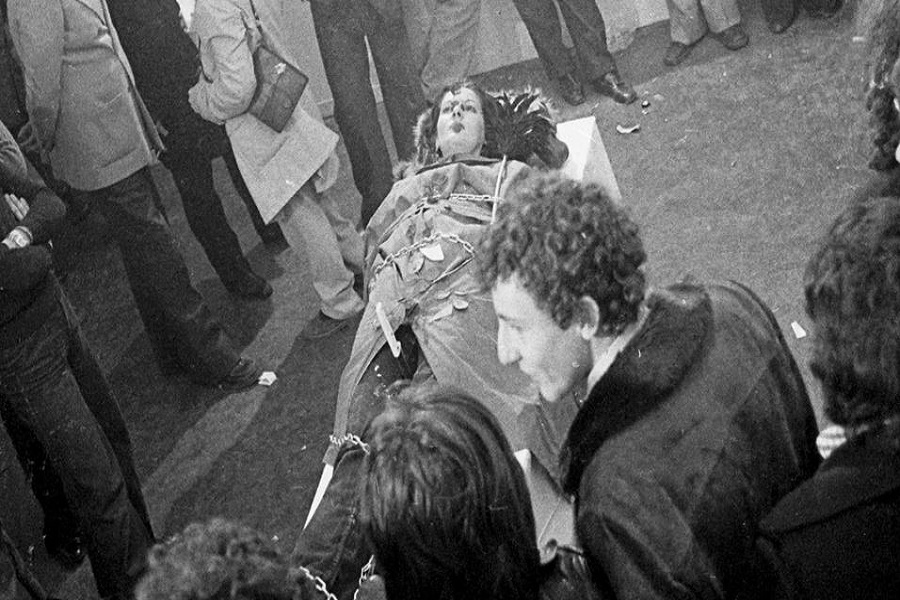- Details
- Written by Ángeles Blanco
Artists nowadays don’t have to take a vow of poverty in order to be successful or to garner recognition. A good example of this is Takashi Murakami, one of the most popular Japanese artists on the international art scene. About his origins he admits: "I wanted to be successful commercially. I just wanted to make a living in the world of "entertainment" and I was very clear about my strategy and what kind of paintings I’d have to do to that end, but since then my motivation has changed."
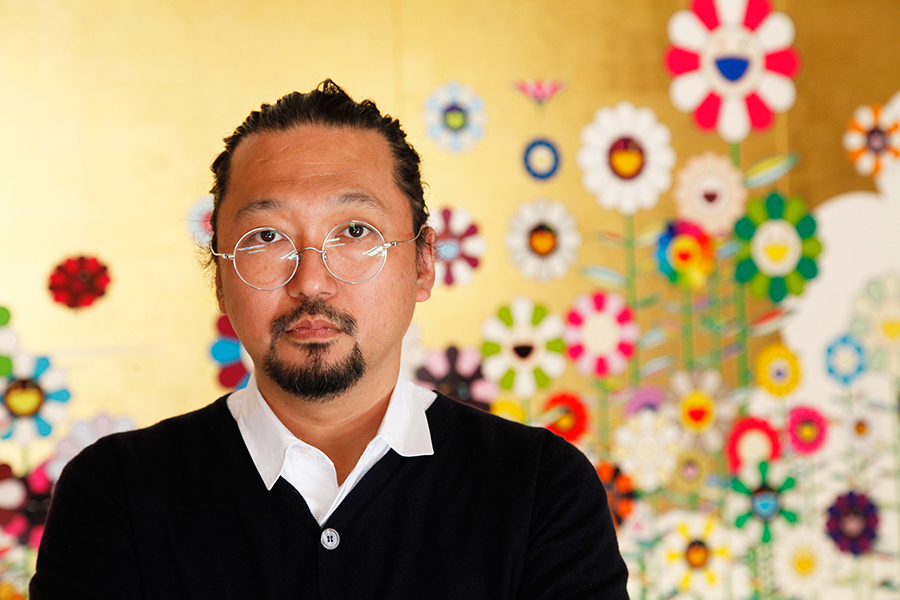
Photo: "Our Gang", available from http://www.japantimes.co.jp/, 26 April 2013
Known as the Japanese Andy Warhol because they both managed to turn art into merchandise and attract mass culture, this fact has led some to see his art as simply a business. But Murakami interconnects high art with popular culture, arguing that art forms part of the economy. He justifies this by saying: "Japanese people accept that art and commerce will rub shoulders; in fact, they’re surprised at the rigid and pretentious hierarchy of Western “high art"."
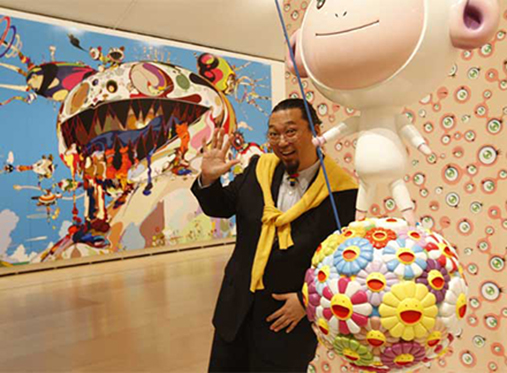
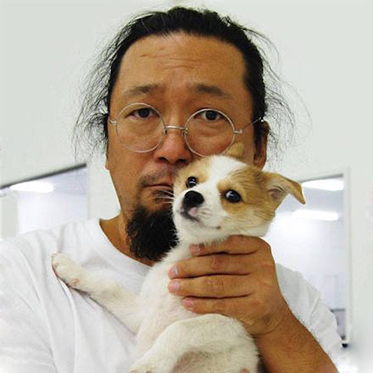
Photo (right): Takashi Murakami, available at http://www.dw.com/
Born in Tokyo in 1962, he left Tokyo University of Fine Arts and Music in 1983 with a PhD in “nihonga”, whereby paintings follow traditional Japanese artistic conventions both in technique and in subject matter and materials. He incorporates elements of Japanese culture from different eras in his work. On the one hand, traditional Buddhist iconography, 12th century painting, Zen painting and composition techniques from the 18th century Edo period, from which he adopts the use of fantastical and unusual images. On the other, he borrows contemporary popular elements of expression, such as Japanese “anime” (animation) and “manga” (comics) and also American pop art. He reworks this diversity of influences into myriad artistic media and formats, his work ranging from paintings reminiscent of cartoons to quasi-minimalist sculptures, giant inflatable balloons, films, watches, T-shirts and other mass-produced merchandise.
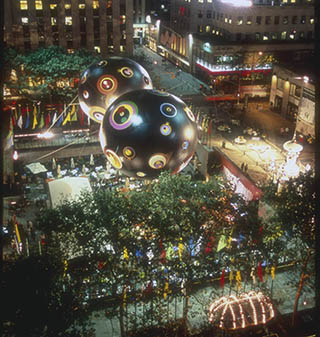
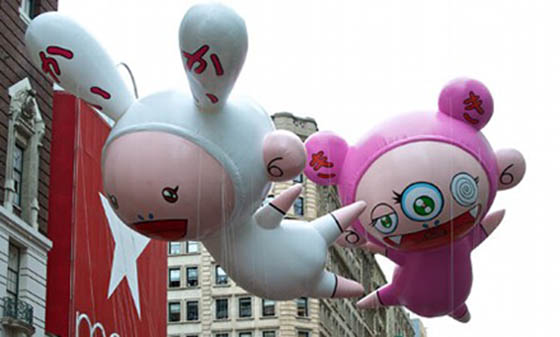
Photo (right): Balloons, available at http://www.terihaartadvisory.com/
His works are colourful and engaging and he uses his wide knowledge of Western art, working from the inside out to represent “Japaneseness” as a tool to bring about a revolution in the art world. "I believe that all artists should have strong, dark emotions within them in order to create works that have energy", and, according to Murakami, the force behind his work is for him "to become a living example of the potential of art."
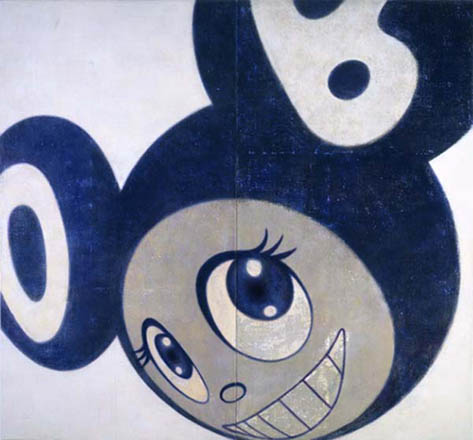
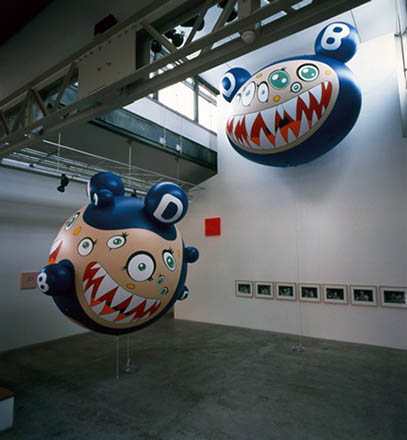
Photo (right): Crazy Z, available at http://www.artnet.com/
Murakami began to make a name for imself in the 1990s, following Japan's economic crisis of the late 1980s, hand in hand with the Nipponese Neo-pop generation. His work has been exhibited in prestigious museums around the world, such as the Tokyo Metropolitan Museum of Art, the Museum of Fine Arts in Boston, the Bard College of Art Museum and the Palace of Versailles.
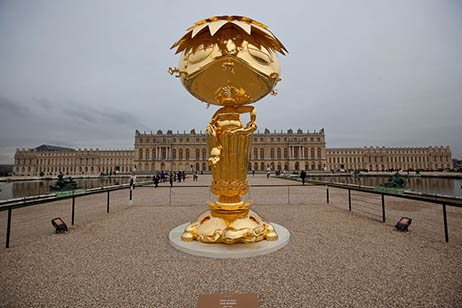
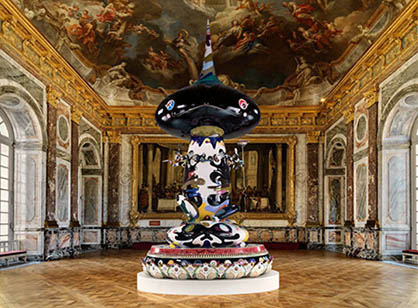
Photo (right): Tongari-kun, available at http://malaysiafinance.blogspot.com.es/
In 1996, he founded the Hiropon factory in Tokyo, which in 2001 became Kaikai Kiki Co. Ltd, an international corporation employing over 100 employees and dedicated to the production, management and commercialization of the art created by this multifaceted artist and also to support and promote up and coming new artists: twice a year, he organizes GEISAI in Tokyo, an art fair that allows young artists to exhibit their works, many of whom have ended up working for him. His company develops diverse projects with real market strategies that cross the boundaries of artistic circles to reach the general public, using mass production, merchandising, manufacturing and made-to-order corporate designs, some of them for prestigious brands such as Louis Vuitton and Issey Miyake.
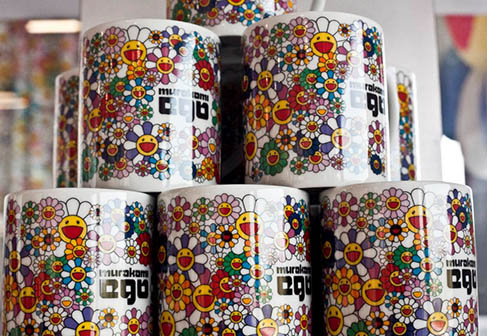
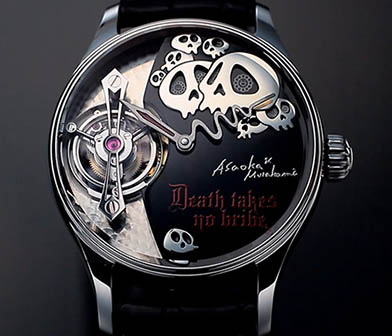
Some of Murakami’s characters have been evolving since the beginning of his career. His alter ego Mr. DOB, for instance, was born in the 1990s as a cute DNA helix (ZaZaZaZaZaZa, 1994) but he has gradually morphed first into a disturbing creature (Tin Tin Castle, 1998) and then a huge monster symbolizing society’s cravings for consumerism (Tan Tan Bo vomiting, 2002). He is one of Murakami’s recurring characters, a kind of logo or trademark, who is reproduced on T-shirts, posters, keychains, etc and has even been brought to life through 3D sculptures all over the world.
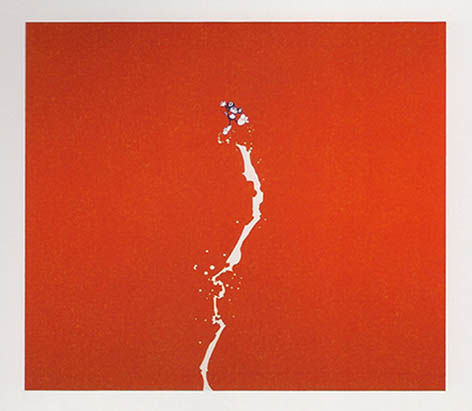
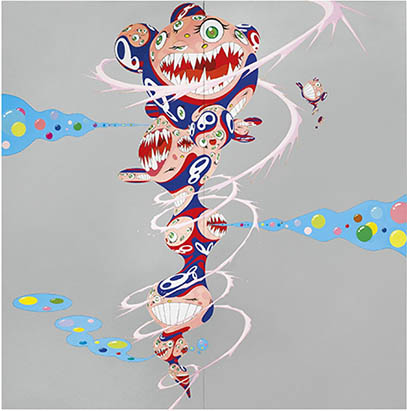
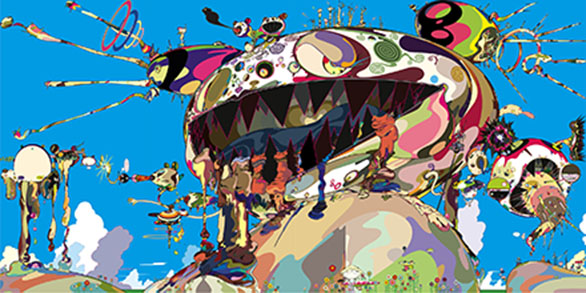
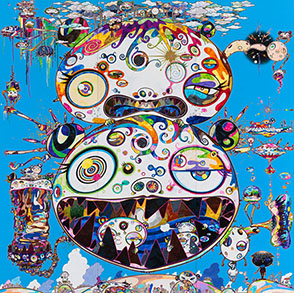
In 2000, Murakami organized a Japanese art exhibition entitled Superflat, linking contemporary Japanese pop culture with Japanese historical art, which gave way to a movement towards mass-produced amusements. This gave rise to the postmodern cultural current of the same name, which refers to its flat style and the absence of depth or persepective in his compositions. This aesthetic, in which everything is depicted in two dimensions, offers an external interpretation of postwar Japanese popular culture through its “otaku” subculture, a term that designates what in the West we would call “geek” or “nerd” and which refers to people obsessive about their hobbies. Hence his invention of the term "POKU", a portmanteau of “pop” and “otaku”: "Everyone works to make a living. Me too. And I hoped that some people would be interested in my art if I offered an expression of it like Poku culture because it's fun."
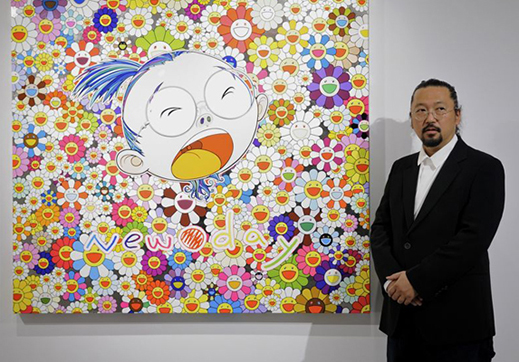
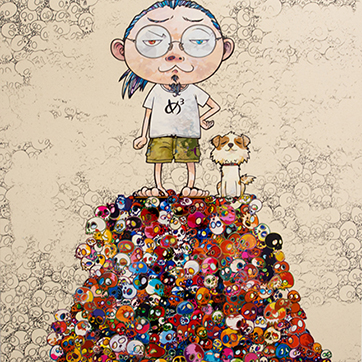
Examples of his work from this period here are Miss Ko2 (1997), a stylized anime-like waitress who wants to be a singer; Hiropon (1997), a young woman with unfeasibly large breasts; My Lonely Cowboy (1998), a naked teenage boy; PO + KU Surrealism Mr. DOB (1998), a large-scale triptych in which his typical superflat monochrome background is broken up by animated images of bulging eyes and razor-sharp teeth; or one of his larger sculptures, DOB in the Strange Forest (1999).
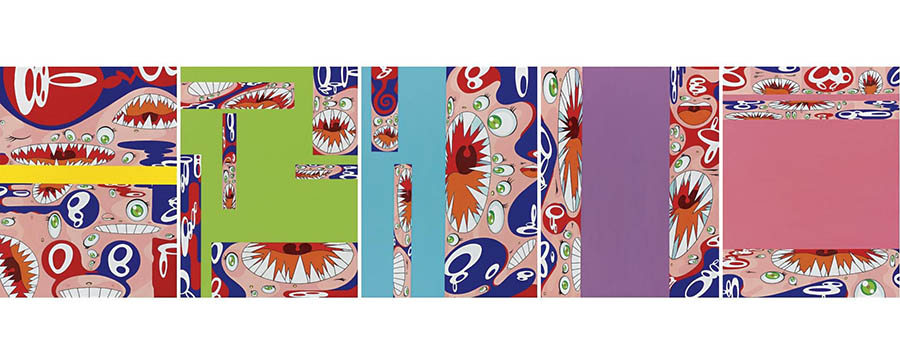
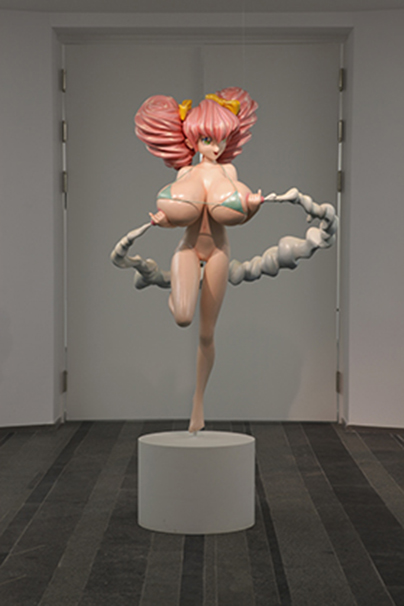
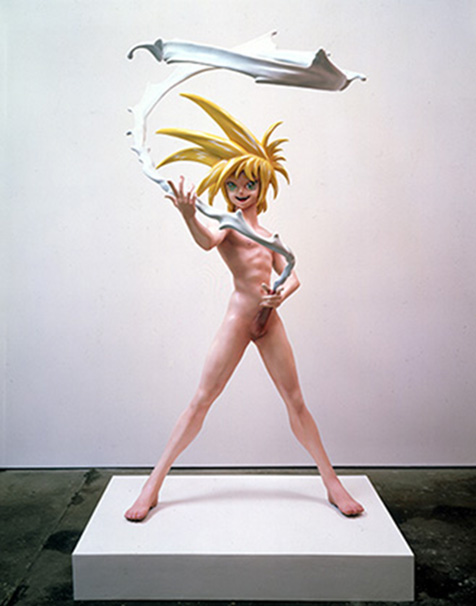
From 2000 on, Murakami has been creating other self-portraits in addition to Mr. DOB: between 2003 and 2005 Mr. Pointy and the Four Guards, based on the four Buddhist Protector deities; in 2004, Inochi, a teenager reminiscent of Spielberg's legendary E.T.
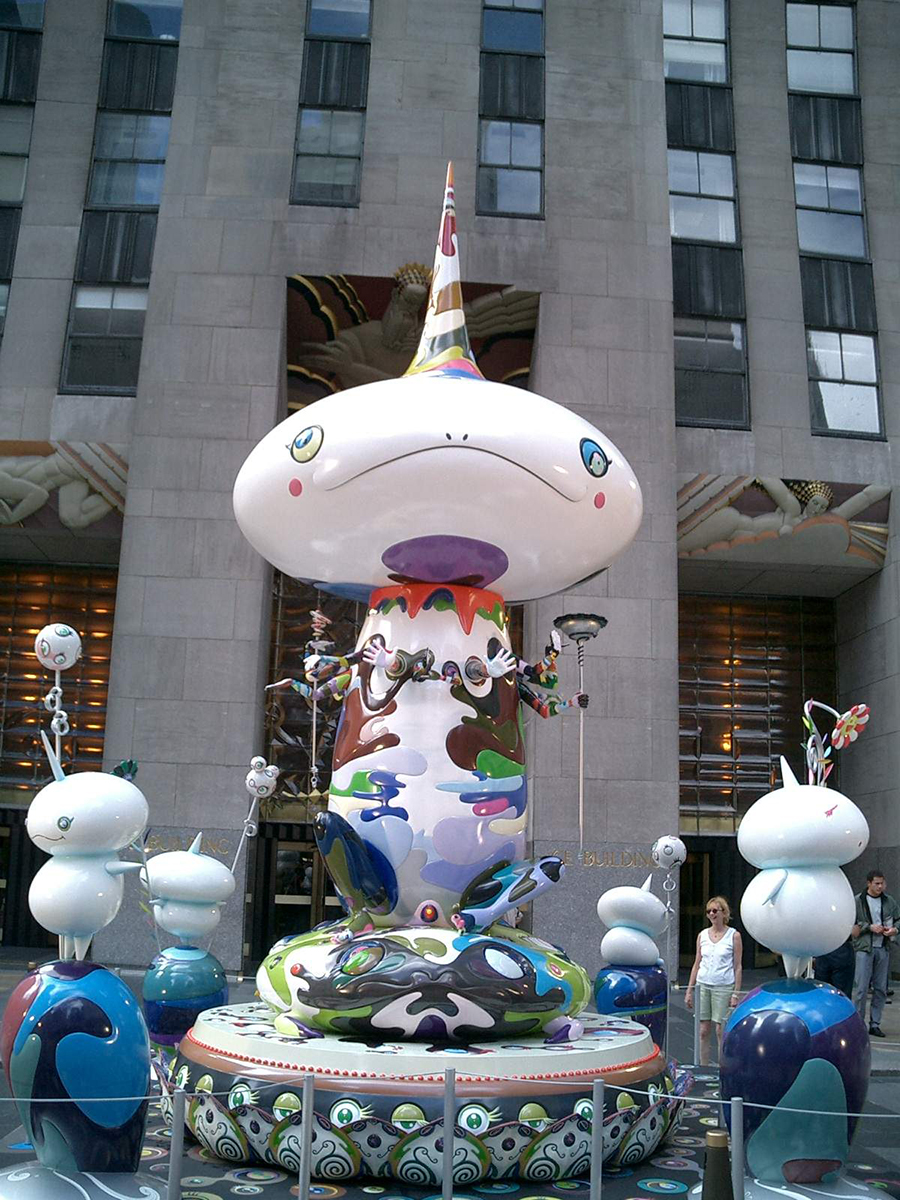
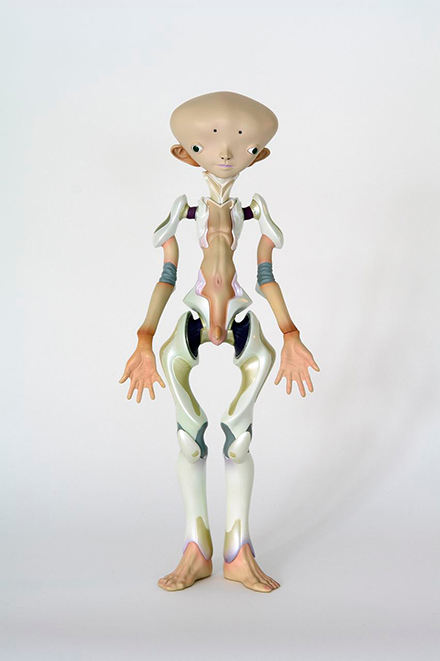
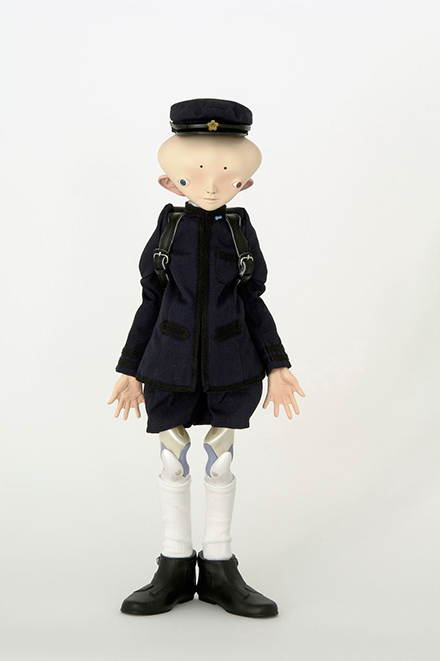
The cute Kaikai and Kiki, whose names derive from the term “kikikaikai” which means "strange but captivating" are the author's spiritual guardians.
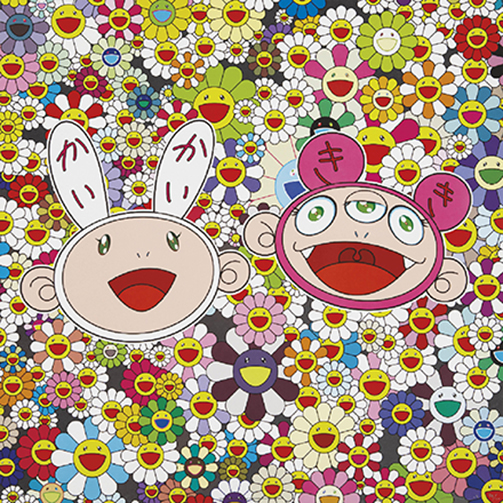
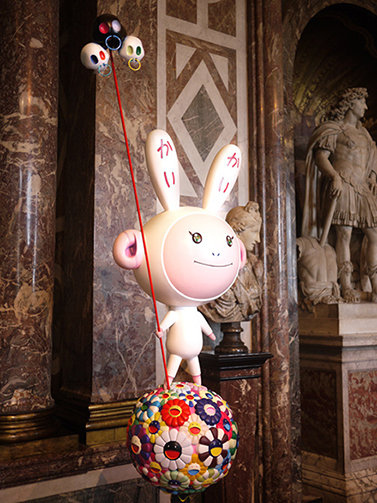
Taking a look at his iconography, we see that one of the most recurrent is fungi, perhaps atomic mushrooms? For those who think so, it might represent the trauma caused by the atomic bombs dropped on Japan in WWII. For others, however, they symbolize male genitalia or a reference to drug-induced hallucinations.
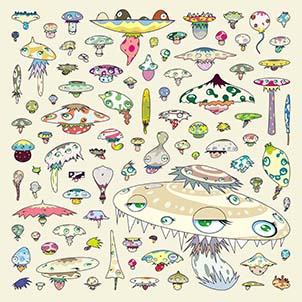
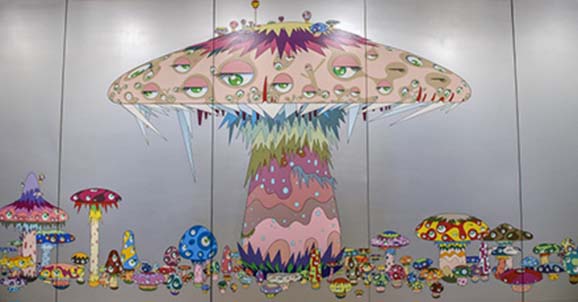
Other motifs are his multicolored daisies with smiling faces and skulls which relate to the aesthetics of “kawaii” which means "cuteness" and which in Japan is used in situations that to Western eyes might seem incongruous. Is it also a critique of Japan's overly consumerist culture with a penchant for the childlike.
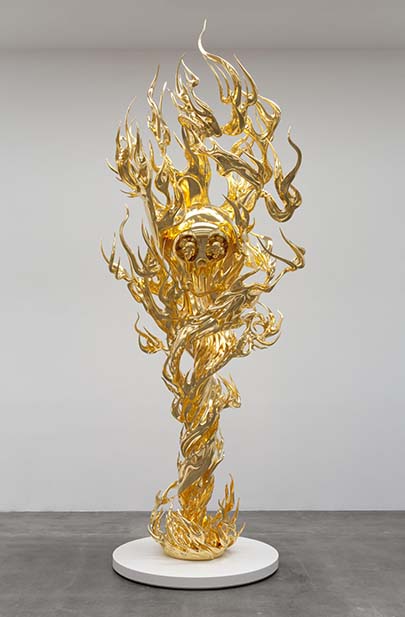
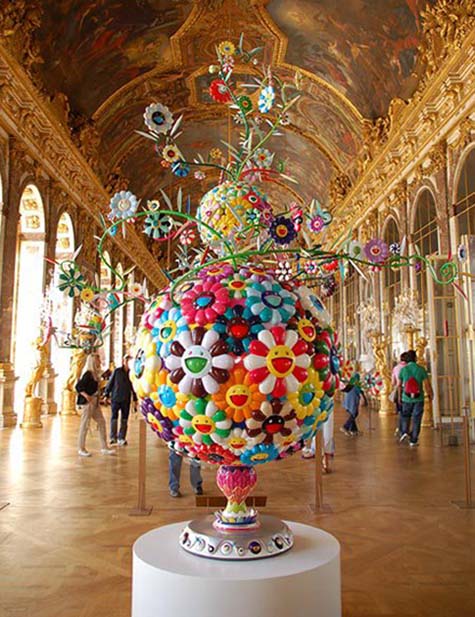
What is obvious is that his career has been unstoppable and that he has presented some very impactful exhibitions such as Coloriage (Cartier Foundation for Contemporary Art, Paris, 2002) and Little Boy: The Art of Japan's Exploding Subcultures (Japan Society, New York, 2005).
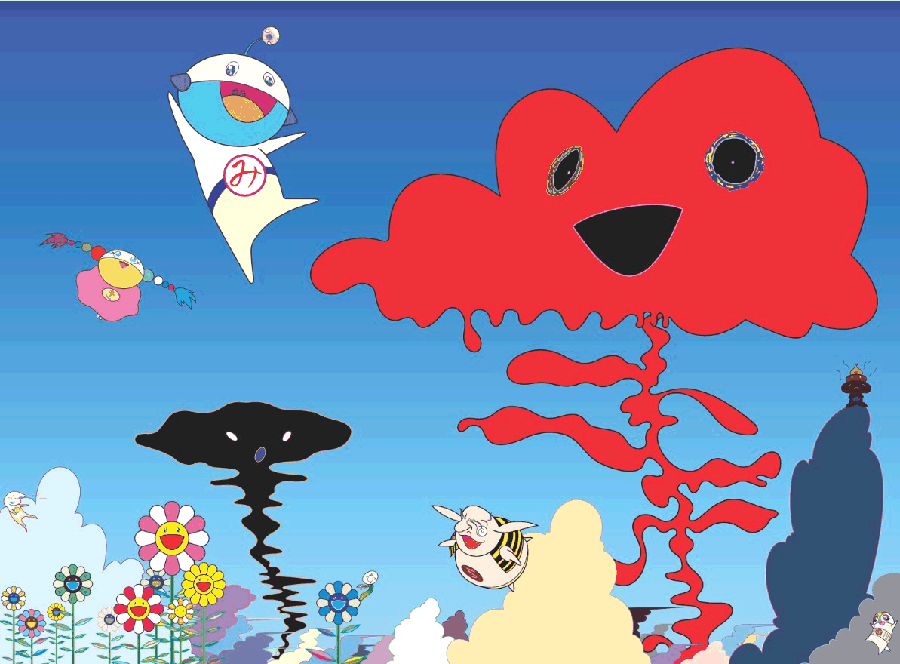
After touring the MoCA in Los Angeles, the Brooklyn Museum in New York and the Museum of Modern Art in Frankfurt, he arrived at the Guggenheim Museum, Bilbao in 2009 with ©MURAKAMI, a retrospective displaying over 90 works of art in different mediums. For instance, there was the evolution over time of Mr. DOB and some of his other iconic characters, his figurative projects inspired by the “otaku” of the late 90s or fantastical sci-fi figures such as SMPKO2, among others. It is worth noting the presence of one of his most important pieces: Oval Buddha, silver (2008), which depicts a Buddha meditating on a lotus leaf. The exhibition rounds off with some abstract paintings all in different techniques (graffiti, Op Art or special effects), some of his animation work and, finally, a compilation of 500 items of merchandising manufactured by his company.
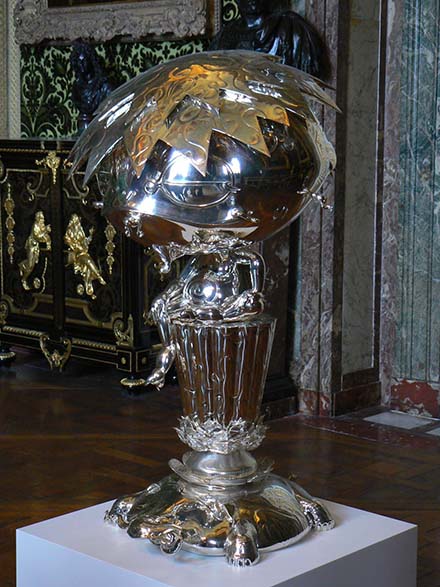
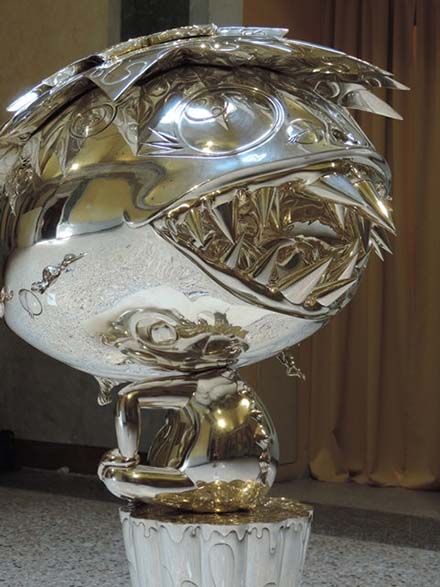
In 2011, following the Tohoku earthquake and tsunami, he hosted “New Day: Artists for Japan”, an international charity auction at Christie's in New York. The Murakami-Ego exhibition, whose centrepiece was an astonishing 100-meter painting inspired by that same earthquake and the Fukushima Nuclear Disaster could be seen in 2012 at the Riwaq Al Hall in Doha, Qatar. In 2014, Takashi Murakami: Arhat Cycle was performed at the Palazzo Reale in Milan in 2014 and, at the Gagosian Gallery in New York, In the Land of the Dead, Stepping on the Tail of a Rainbow, which showcases the themes that the artist had developed in recent years about the origin of religions.

As a keen anime enthusiast, Murakami then moved onto action and set his characters in motion. He has made short videos, such as Pharrel Williams’ It Girl, but he has also undertaken major projects. Jellyfish Eyes is the first feature film in a trilogy that he directed and produced himself. It premiered in April 2013 at the County Museum of Art in Los Angeles and has been screened in museums and cinemas around the world. For 90 minutes, the artist takes us, through animation and real people, to the Japan that suffered the 2011 earthquake and the Fukushima disaster, unleashing the full array of colourful creatures to which we have grown accustomed. It was not easy for this project to come to fruition because of the artist's demands, as he himself acknowledges: "It's not a simple or a nice process. At the end of the first film, the team was so fed up they didn't want to work on the second."
The unusual thing about Murakami is his use of new technology: every creation begins as a sketch in one of his many pocket notepads. These drawings are scanned and from there, reworked in Adobe Illustrator, the composition retouched and thousands of colours played around with until the final version is delivered to his assistants who print them onto paper, silkscreen the outlines onto canvas and only then does the painting begin. He himself acknowledges: "Without the support of technology, I could never have produced such a large number of works efficiently and the work wouldn’t have been so intense."
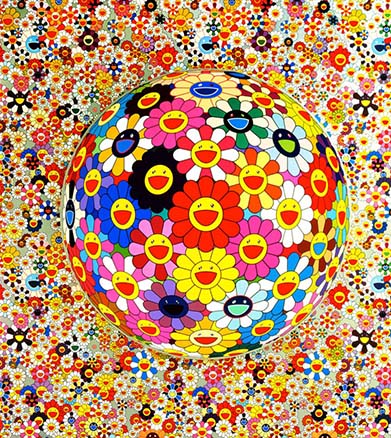
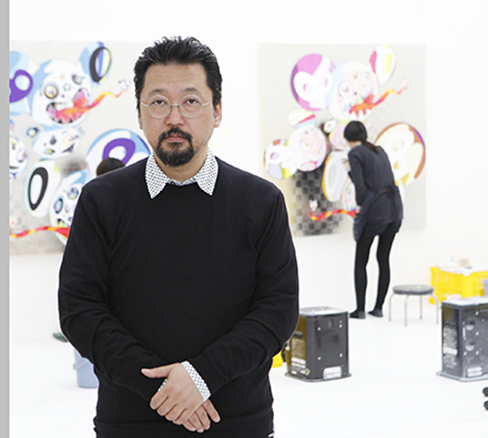
Through his work, Murakami plays with contrasts and double meanings: East and West, past and present, high and low culture, sweetness and perversion, humour and social critique ... while still being consistently fun and accessible. According to him, an artist is someone who understands the boundaries between different worlds and makes an effort to familiarise themself with them.
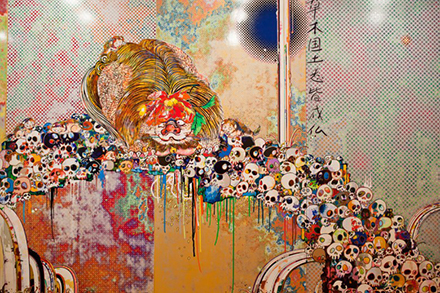
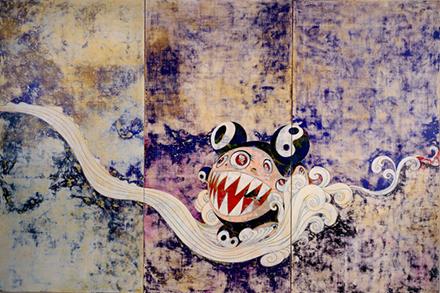
His art, which at first glance could be dismissed as naive or superficial, is actually a complex art project which one discovers, on closer inspection, to be thoughtful and stimulating. The artist does not want to confine himself to just copying Western culture and behind each choice of his seemingly innocent figurines lies a social critique denouncing consumerism and the lack of cultural structures in Japan. He has said: "I express despair. If my art seems positive and cheerful, I doubt it would be accepted onto the contemporary art scene. My art is not pop art. It is a recognition of the struggle of people suffering discrimination."
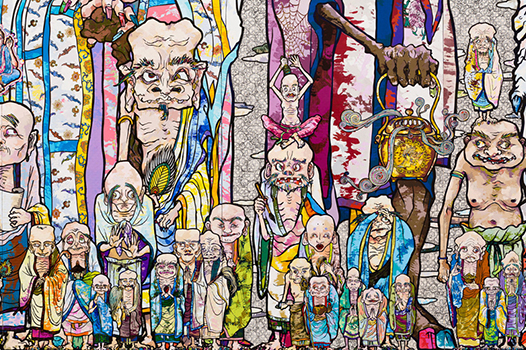
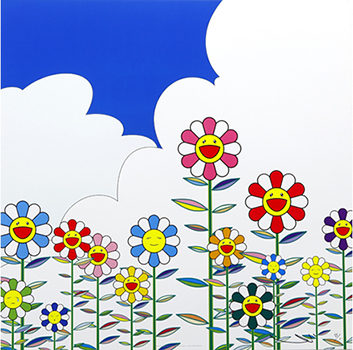
"I’m surprised at the impact this exhibition has had." These are the words of Michael Darling, curator at the Museum of Contemporary Art in Los Angeles, and regarding the artist himself, he says: "Superflat also alludes to the leveling of distinctions between high and low. Murakami likes to brag that he can make a million-dollar sculpture and then take the same theme and produce a load of cheap rubbish."
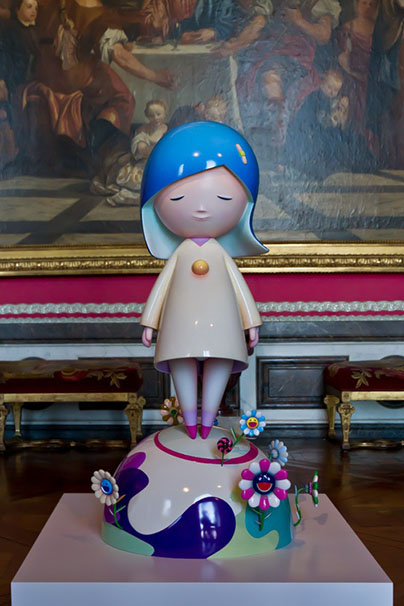
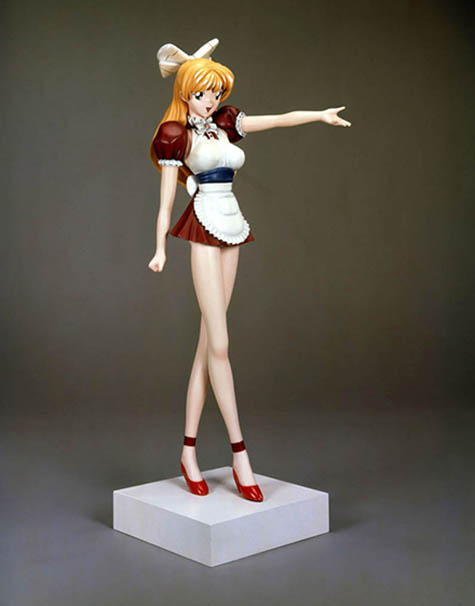
Despite some opinions railing against commercialization in his art, Murakami's commitment to achieving whatever he sets out to is undeniable and that has earned him a place among the most celebrated and in-demand artists of today.
(Translated from the Spanish by Shauna Devlin)
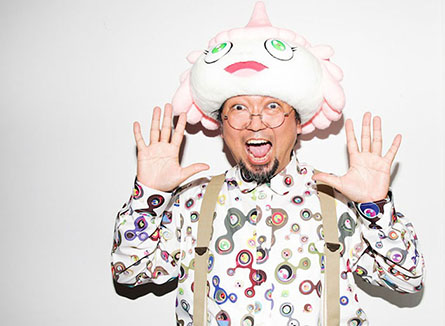
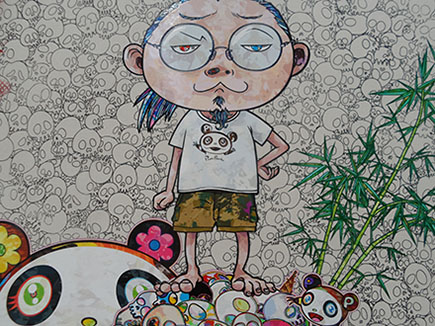
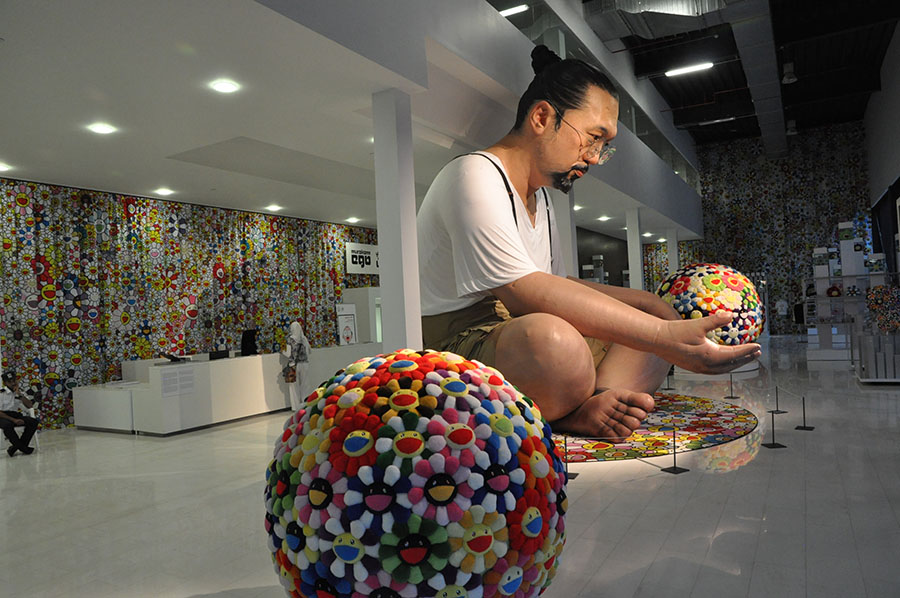
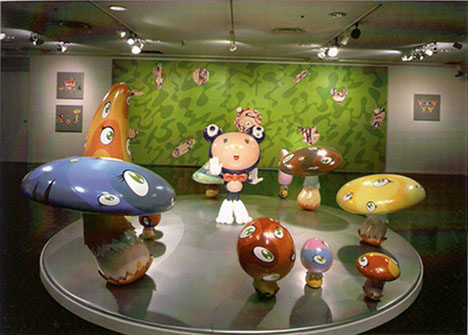
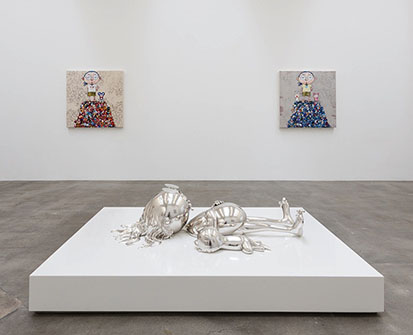
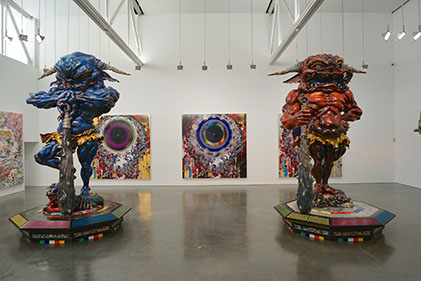
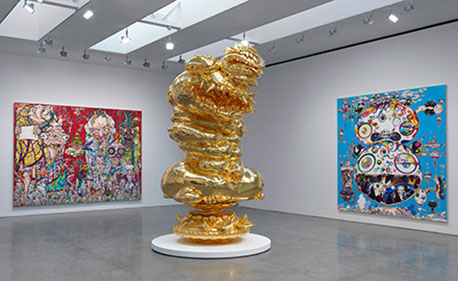
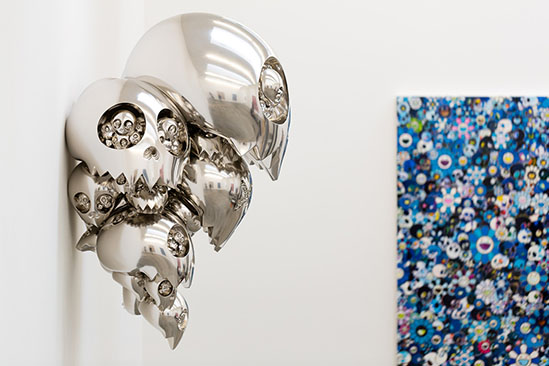
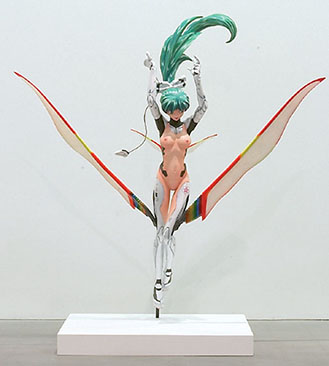

- Takashi Murakami: Biography, Works and Exhibitions - - Alejandra de Argos -
- Details
- Written by Marta S. Galindez
Life is art and art is life ..... or are they just two sides of the same coin? It is figures such as Salvador Dali who bring much-needed light to this shady, eternal question. The Catalonian artist from Cadaqués, one of the most globally important in art history, made himself and his life a joint work of art that has endured over time, complementing his magnificent visual oeuvre and revealing one of the most fascinating personalities of the 20th century. “The uniform is essential in order to conquer. In my entire life, rare have been the occasions when I've demeaned myself by wearing civilian clothing. I'm always dressed in my Dali uniform”. The artist reflected on these comments in his book Diary of a Genius, where his patent self-love jumps out from the page ~ an egocentric attraction that made him many enemies.
Dali: art, egocentricity and provocation
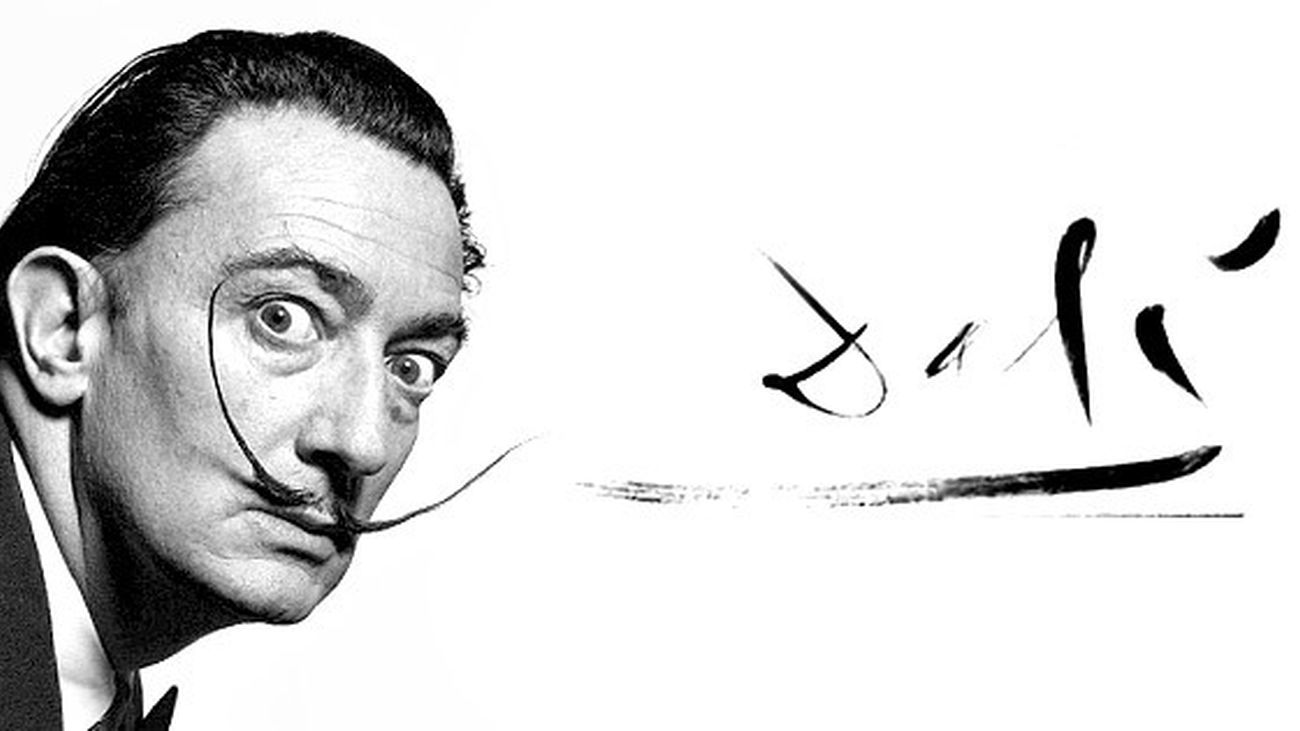
Portrait of Dali with signature. Poster for the exhibition "Dali" organised by the Reina Sofia Museum, Madrid in 2013 c/o Telemadrid.es
Life is art and art is life ..... or are they just two sides of the same coin? It is figures such as Salvador Dali who bring much-needed light to this shady, eternal question. The Catalonian artist from Cadaqués, one of the most globally important in art history, made himself and his life a joint work of art that has endured over time, complementing his magnificent visual oeuvre and revealing one of the most fascinating personalities of the 20th century. “The uniform is essential in order to conquer. In my entire life, rare have been the occasions when I've demeaned myself by wearing civilian clothing. I'm always dressed in my Dali uniform”. The artist reflected on these comments in his book Diary of a Genius, where his patent self-love jumps out from the page ~ an egocentric attraction that made him many enemies.
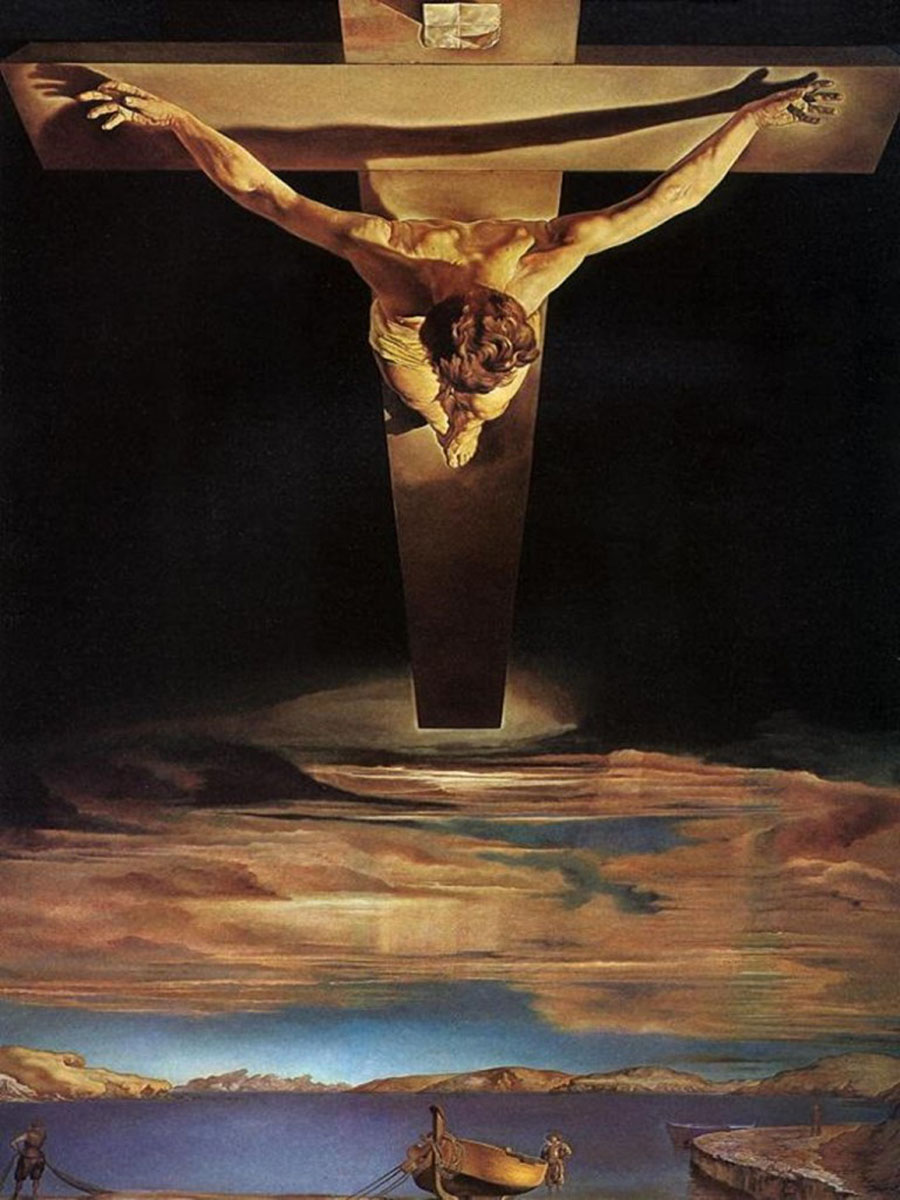
Christ of St John of the Cross (1951). Kelvingrove Art Gallery and Museum, Glasgow c/o Totenart.com
Controversy, mystery and genius were Dali's constant companions. As an artist, he left an immortal legacy; as a person, he gifted society his unforgettable persona; and as a writer, he produced an extraordinary, intimate and recently-revindicated body of work. Today, people queue around the block at exhibitions all over the world and any news concerning his life provokes huge interest. Dali collaborated with and/or had links with greats such as Garcia Lorca, Picasso, Buñuel and Hitchock, creating images and works that remain in our collective subconscious to this day. Accompanied and awed by the powerful character of Gala, his muse and wife til the day of her death, Dali forged his own particular, spectacular imagery that has passed the test of time and become an integral part of contemporary culture, generation after generation.
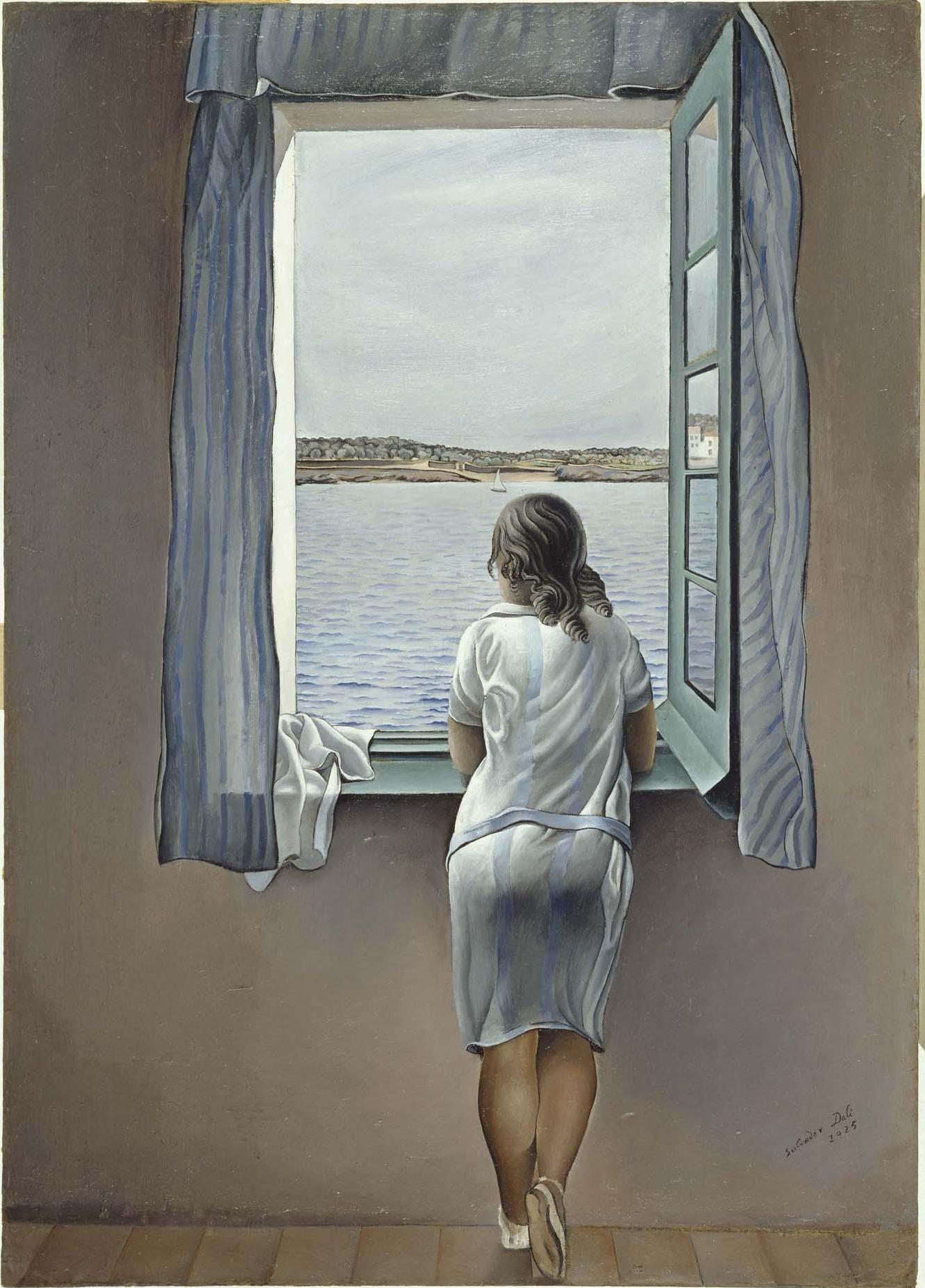
“Figure at a Window” (1925). Reina Sofia Museum, Madrid c/o Museoreinasofia.es
Early years: mediocre student and budding artist
Salvador Dali was born at the turn of the century in Figueres (Girona) on 11 May 1904 to parents Salvador Dalí Cusí and Felipa Domenech. His education began in 1908 in the local state school but his father enrolled him at the Hispanic-French Immaculate Conception College four years later. Dali turned out to be a mediocre student but, after coming into contact with Impressionism through the works of Ramon Pichot, his life takes a different turn. In conjunction with attending school, in 1916 he also begins drawing classes with the painter Juan Núñez.
In 1919 and at the remarkably young age of fifteen, Dali takes part in his first exhibition at Figueres Town Theatre. Unbeknownst to him, this was a moment that would eventually come full circle and culminate in the transformation of the building into the Dali Theatre-Museum, inaugurated in 1974. He also takes his first steps as a writer, something he was absolutely passionate about and that he often gave more relevance to than his plastic art.
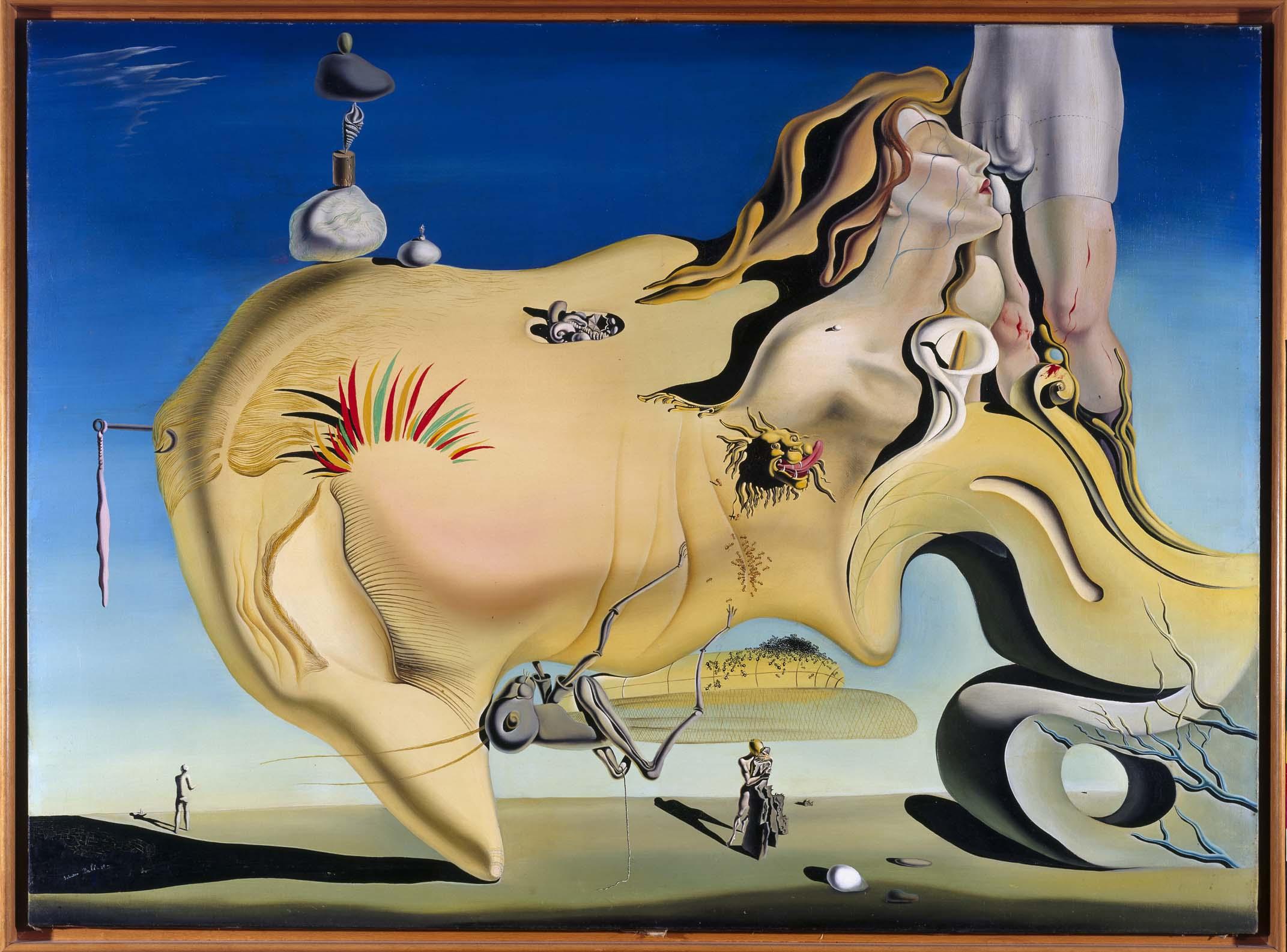
“The Great Masturbator” (1929). Reina Sofia Museum, Madrid c/o Museoreinasofia.es
From Figueres to Madrid: the Academy years
The father figure remained omnipresent in Dali's work throughout his whole life and it was his father who allowed him to train as an artist, on condition he studied at the School of Painting, Sculpture and Engraving at Madrid's Royal Academy of Fine Art. Dali willingly accepted. His mother's early death in 1921 saw her presence relegated to the background as his father remained the most important influence on his life. Their relationship was always plagued with confrontations, disagreements and subjugation but was also marked by Dali's profound admiration for his father.
During his training in the Spanish capital, Dali moved in the same circles as intellectuals, filmmakers and writers of the standing of Buñuel and Garcia Lorca, among others. In 1923, he was expelled form the Academy and returned to his birthplace, where he studied engraving techniques. In under a year, the budding artist had returned to Madrid and participated in his first exhibitions there. During this time, he renounced the avant-garde and pursued traditional Spanish and Italian painting. In 1926, he was expelled definitively from the Academy, returned to Figueres and devoted himself entirely to painting.
Film ~ “Un chien andalou” (1929)
Lorca and Gala: two people, two influences
The relationship between Dali and Federico Garcia Lorca has generated countless articles, speculation and controversy in equal measures. After the first few years of friendship, Dali begins to distance himself from Lorca for fear of being associated with the poet's political stance and his widely-known homosexuality. In 1929, Dali travels to Paris and comes into contact with Surrealist artists, which was to be a pivotal moment in his career. He immerses himself completely in a movement that alligns perfectly with his runaway imagination, his egocentricity and his impeccable pictorial technique. A year earlier, his film collaboration with Luis Buñuel, "Un chien andalou" was released in Paris, cinema being one of his passions and an art form to which he would return repeatedly in subsequent years, collaborating with revered names such as Alfred Hitchcock.
The summer that same year saw a decisive incident in the artist's life. He meets Gala, married at the time to Paul Eluard, when they stayed with him in Cadaqués. Gala leaves Eluard for Dali who would continue to show his deep devotion towards her for the rest of his life.
“I am surrealism”: the embodiment of a movement
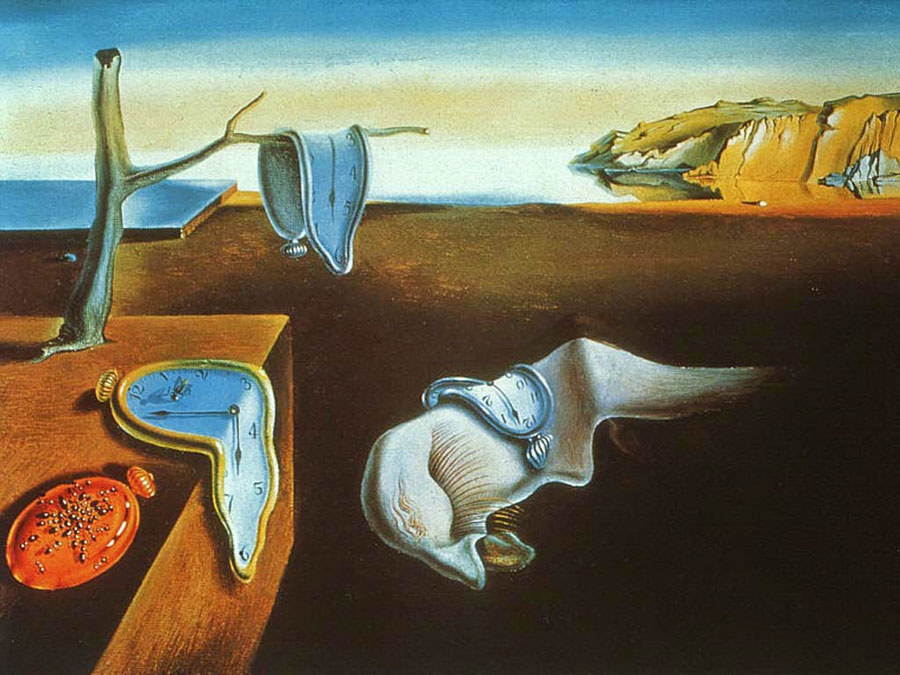
The Persistence of Memory (1931). Museum of Modern Art, New York c/o Artesubastas.es
Dali's commitment to surrealist philosophies and manifestations brought him success from the outset and he quickly became one of the leading exponents of the movement on the world stage, going so far as to proclaim that "I am surrealism". This was not, however, that far removed from reality: Dali had begun to transform his character, his surroundings and his physical presentation into a multi-layered, ever-changing work of art that would continue right up until his death. He even came up with his very own surrealist technique that he dubbed "the Paranoiac-Critical Method" and defined as "a spontaneous method of irrational knowledge based on the critical and systematic objectivity of associations and interpretations of delirious phenomena."
Over the following years, both Dali's personality and his art would become influenced by two great figures: Pablo Picasso, who he met around 1935, and Sigmund Freud, who he interviewed in 1938 thanks to writer Stephan Zweig's intervention.
Boom and bust: the years of decline

“The Temptation of St Anthony” (1946). Royal Museums of Fine Arts of Belgium, Brussels c/o Arteac.es
In the 1940's, Dali's work was beginning to enjoy worldwide recognition. This success distanced him from his old, compromised friendships but won him the favour of General Franco's dictatorship which welcomed him with open arms. His paintings and sculptures then began to show signs of repetition, as Dali renounced innovation in favour of what he knew full well worked for him and the public. His cult-of-self became another of his obsessions and, during the Swinging Sixties, he concentrated on creating his own museum in Figueres, convinced of its historical relevance. Also, from 1965 onwards, Dali began compulsively signing sheets of blank paper for future lithographs and his work became more confusing and disjointed. It was in 1975 that the artist's decline, in health and old age as well as his art, left no room for doubt, a fall culminating in Gala's 1982 death and Dali's seclusion first in Pubol Castle and later in the Galatea Tower.
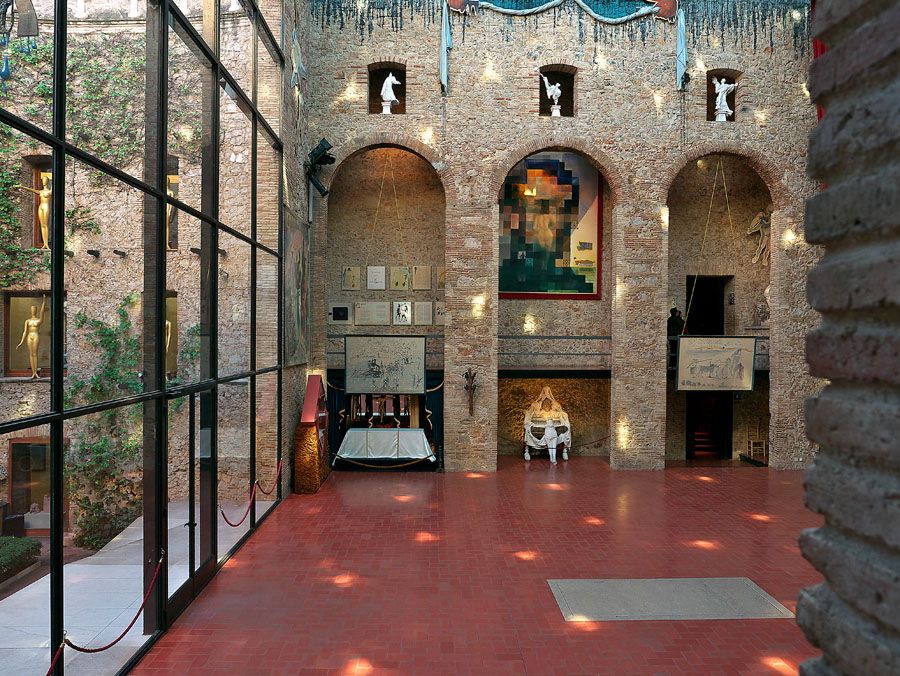
Interior of the Dali Theatre-Museum (Figueras), with the painting "Abraham Lincoln" c/o Wikipedia
Since the 1980's, any Dali exhibition, anywhere in the world, in the greatest contemporary art museums and galleries (such as the Pompidou Centre, Paris or the Tate Britain, London) have attracted huge crowds of visitors. The artist himself, however, was no longer interested in art and, ultimately, succumbed to the worst of his fears, death, and passed away in 1989.
Exhibitions
Exhibitions of Salvador Dali's work are events that spark international interest and attract hundreds of thousands of visitors. Since his first solo exhibition in 1929 until the present, the world's most important museums continue organising retrospectives showcasing the most intriguing facets of his life and work.
Salvador Dali (2012-13)
November 21st 2012 saw the inauguration of a Dali anthology exhibition at the Pompidou Centre in Paris which sold over 760,000 tickets, making it the second most successful ever recorded in the museum's history, after the previous Dali retrospective of 1979 which had attracted 850,000 visitors.
Dali (All of the poetic suggestions and all of the plastic possibilities) (2013)
In 2013, Madrid's Reina Sofia Museum opened what was considered one of the Spanish capital's most important exhibitions of the year: Dali (All of the poetic suggestions and all of the plastic possibilities). The retrospective comprised over 200 works and was one of the most extensive ever dedicated to the artist. In the words of Manuel Borja-Villel: “as opposed to the anecdotal character, we wanted to return to the essential Dali, the artist who is a fundamental figure in 20th century art."
Media: Dali (2015-16)
In 2015, the Gala-Salvador Dali Foundation managed to bring the Catalan artist's work to China in the form of a grand retrospective comprising over 200 multi-media pieces relating to Dali's life and work and including twelve paintings. It was to be the most important Spanish cultural event of the year in a country where surrealism was still largely unfamiliar to its curious audience.
Dali (2016-17)
China was not alone in the sights of the Gala-Salvador Dali Foundation. The 2016 Tokyo exhibition "Dali" gathered together pieces, many of them rarely seen before, from the world's three most important collections (The Dali Foundation in Figueras, the Reina Sofia Museum in Madrid and the Salvador Dali Museum in St Petersburg, Florida) along with other works lent by Japanese institutions.
Books
“The secret life of Salvador Dali”. Salvador Dali, 1942
Dali combined two of his passions in several of his books: writing and the cult of his own personality. This "false" autobiography centres on certain moments in his childhood and adolescence with much irony but not much respect for the truth. Dali recounts the journey from his early years as a student and teenager up to his fame as a world-renowned artist, imbibing each and every page with his inimitable personality.
“Les diners de Gala”. Salvador Dali, 1973
First published in the 1970's, “Les diners de Gala” is an absolute gem that Taschen Books decided to re-edit in 2016. Its pages contain a total of 136 surrealist recipes illustrated with photographs, drawings and collages by Dali. The recipes reflect the artist's powerfully vivid imagination, peppered with erotic references and with excess as their main ingredient. Dali's passion for food is evident here, reflected in the paraphernalia of the exotic dinner-performances organised by Salvador and by Gala.
“The Shameful Life of Salvador Dali”. Ian Gibson, 1998
Without a shadow of a doubt, Ian Gibson's biography of the persona and life of Dali is the most in-depth and exhaustive of those published to date. The Irish author's research brings to light a huge amount of hitherto undiscovered details as he constructs a complex narrative fabric that reveals vast areas of the complicated personality of the Catalan genius. Featured in its pages are the likes of Garcia Lorca, Freud, Picasso, his wife Gala and many other characters close to Dali, thus creating a fascinating, once in a lifetime mise-en-scène.
(Translated from the Spanish by Shauna Devlin)
- Salvador Dali: Biography, Works and Exhibitions - - Alejandra de Argos -
- Details
- Written by Marta Sánchez
“Art is the guarantee of sanity. Pain is the ransom of formalism. That's the most important thing I have to say." These words couldn't be a truer reflection of what the artist Louise Bourgeois experienced during her lifetime. Considered one of the most influential, powerful and profound creators of the 20th and 21st centuries, Bourgeois (1911 - 2010) persevered in the exercise of her very particular artistic imagination until the day of her death at the age of 98.
Louise Bourgeois: Art From The Heart
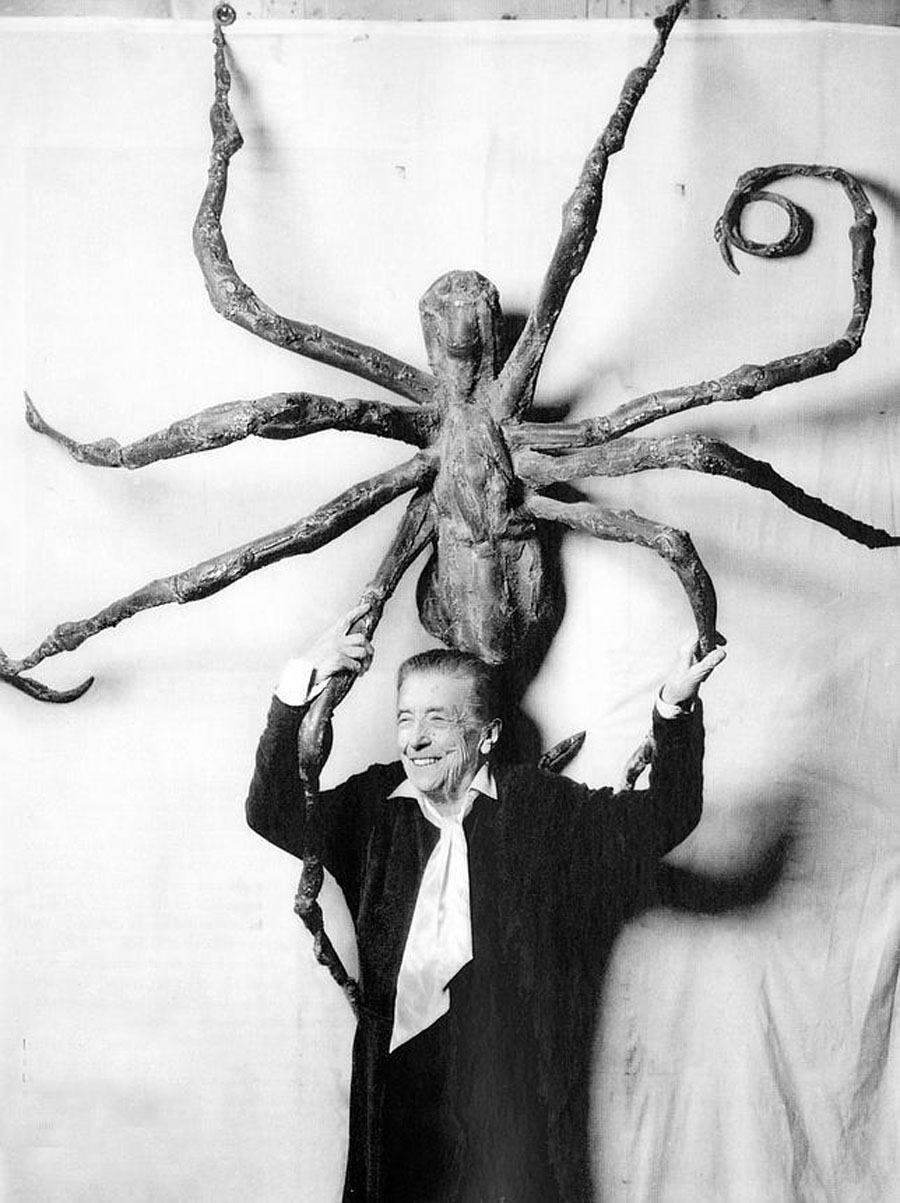
Louise Bourgeois as the "mother of spiders". Photo © Peter Bellamy @ www.crystalbridges.com
“Art is the guarantee of sanity. Pain is the ransom of formalism. That's the most important thing I have to say." These words couldn't be a truer reflection of what the artist Louise Bourgeois experienced during her lifetime. Considered one of the most influential, powerful and profound creators of the 20th and 21st centuries, Bourgeois (1911 - 2010) persevered in the exercise of her very particular artistic imagination until the day of her death at the age of 98. Heavily influenced by her lived experience, her childhood and her family environment, her work displays a creative core of the highest order covering hundreds of stylistic bases, formats, materials and narratives. Her works are neither mere plastic nor empty spectacle. They are personal accounts that extend out and relate to the whole collective of human beings, wearing her heart and innermost feelings on her sleeve, shamelessly, in order to reach that same profundity in her spectators. Her unmistakable spider sculptures, her unsettling "Cells", her poetic yet disturbing engravings constitute a vast, unique and fascinating trajectory that transcends the edges of reason and cultural boundaries to plumb the intimate depths of whoever contemplates or engages with her work.
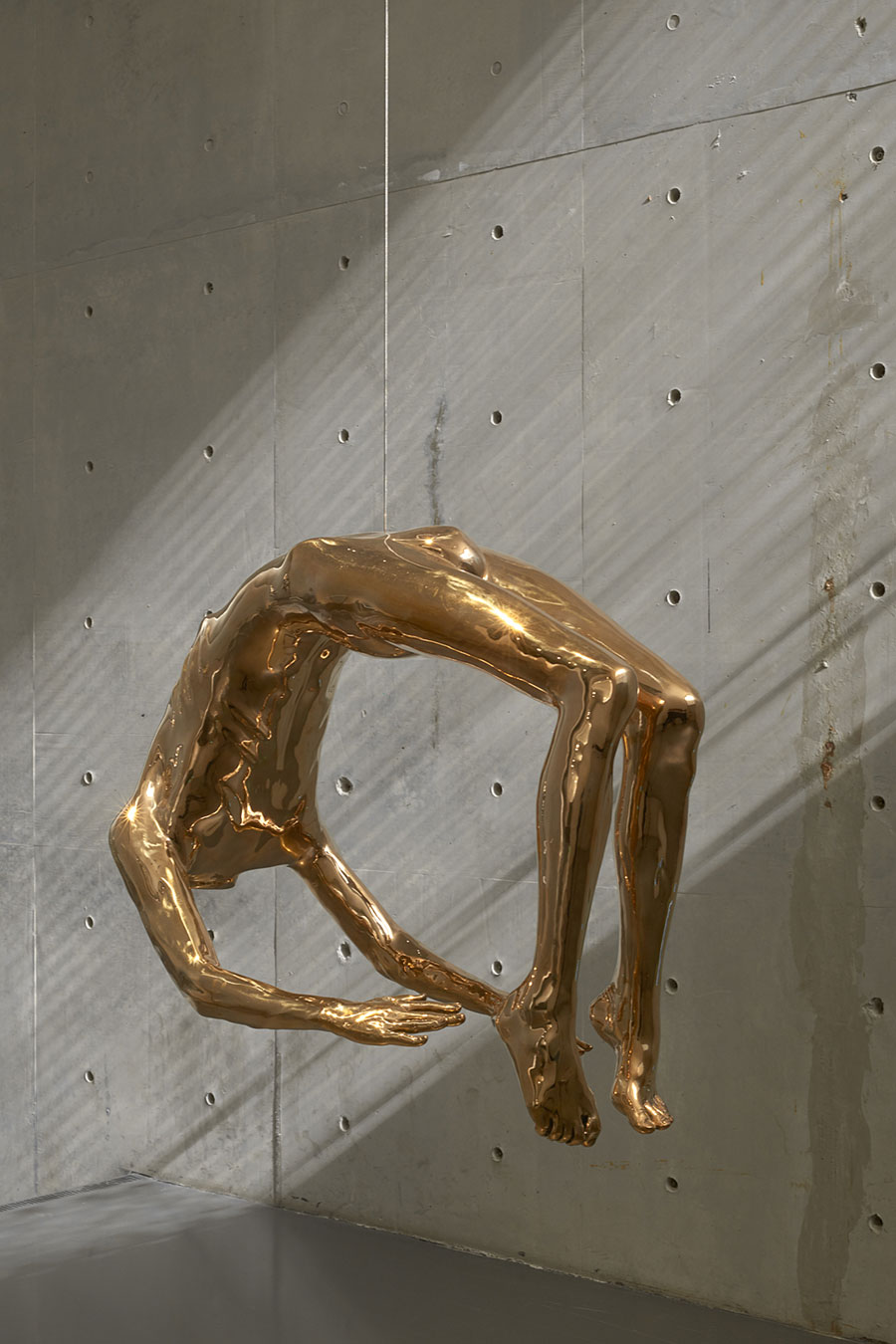
Arch of Hysteria (1993). Museum of Modern Art, New York @ www.moma.org
A childhood woven around her family
Louise Joséphine Bourgeois was born in Paris in 1911 into a family with close ties to the textile industry. Her parents owned a gallery and a restoration workshop with looms where they would weave their own, repair and sell tapestries. This circumstance was to leave a lasting mark on the work of Bourgeois who, throughout the rest of her life, would include fabric, cord, wool and net in a large part of her creations. While her family situation was a comfortable, nurturing and protective one, it was also somewhat unstable with her mother Joséphine contracting a severe case of Spanish flu in 1921 when Louise was just ten. A year later, the family hires an English governess by the name of Sadie Gordon Richmond who becomes a lover to Louise's adulterer father and spends inordinate lengths of time living in the family home as such. This complicated living environment would have a profound effect on Louise's character and she was to experience deep feelings of abandonment and an intense dread of the loss of her loved ones for the remainder of her life.
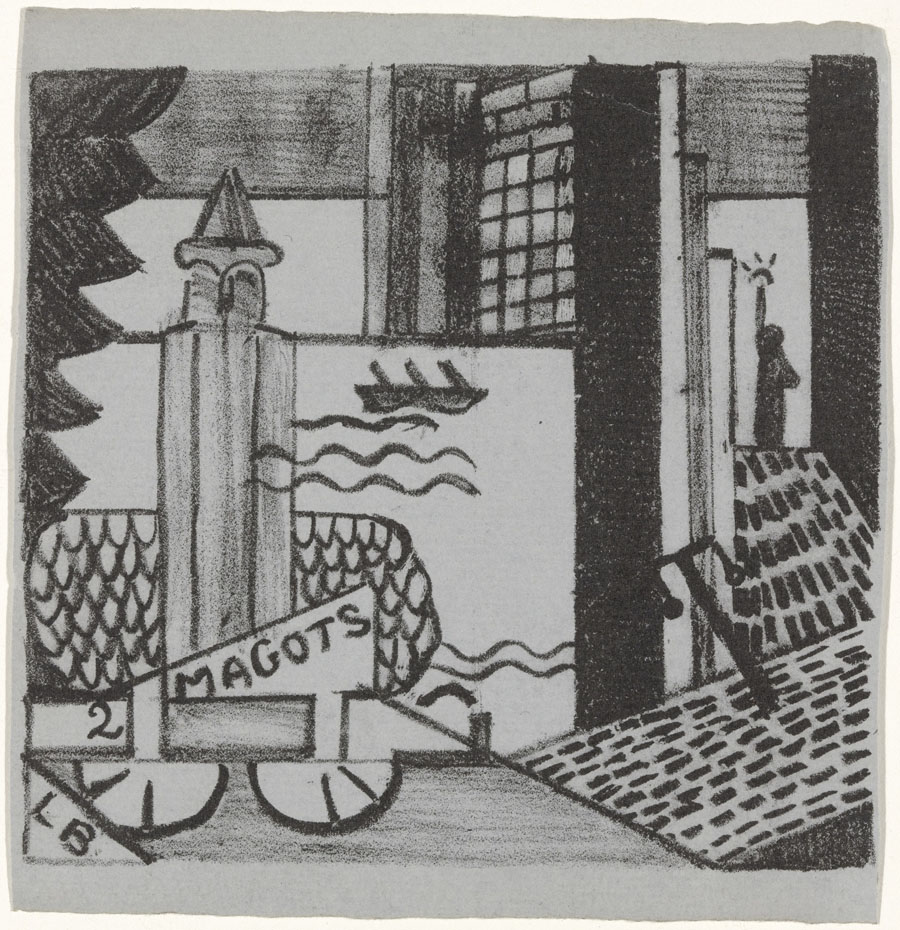
Saint Germain (1938). Lithograph on paper @ www.moma.org
At 12, Bourgeois' father asks her to collaborate in the family business by contributing her own drawings and patterns. Our budding artist combines this with both her education and the large amounts of time she spends caring for her invalid mother who would suffer repeated relapses and die in 1932 when Louise was 21. That same year, Bourgeois graduated with a first class BA (Honours) in Philosophy although her mother's death plunged her into a deep depression from which she would eventually decide to extricate herself by means of her art. She abandons her studies and seeks out the many workshops that Montparnasse and Montmartre were abuzz with at that time. In 1938, she studies with Fernand Léger, cuts all ties with the family business and opens her own art gallery. This is also the year she marries the art historian Robert Goldwater and moves with him to New York.
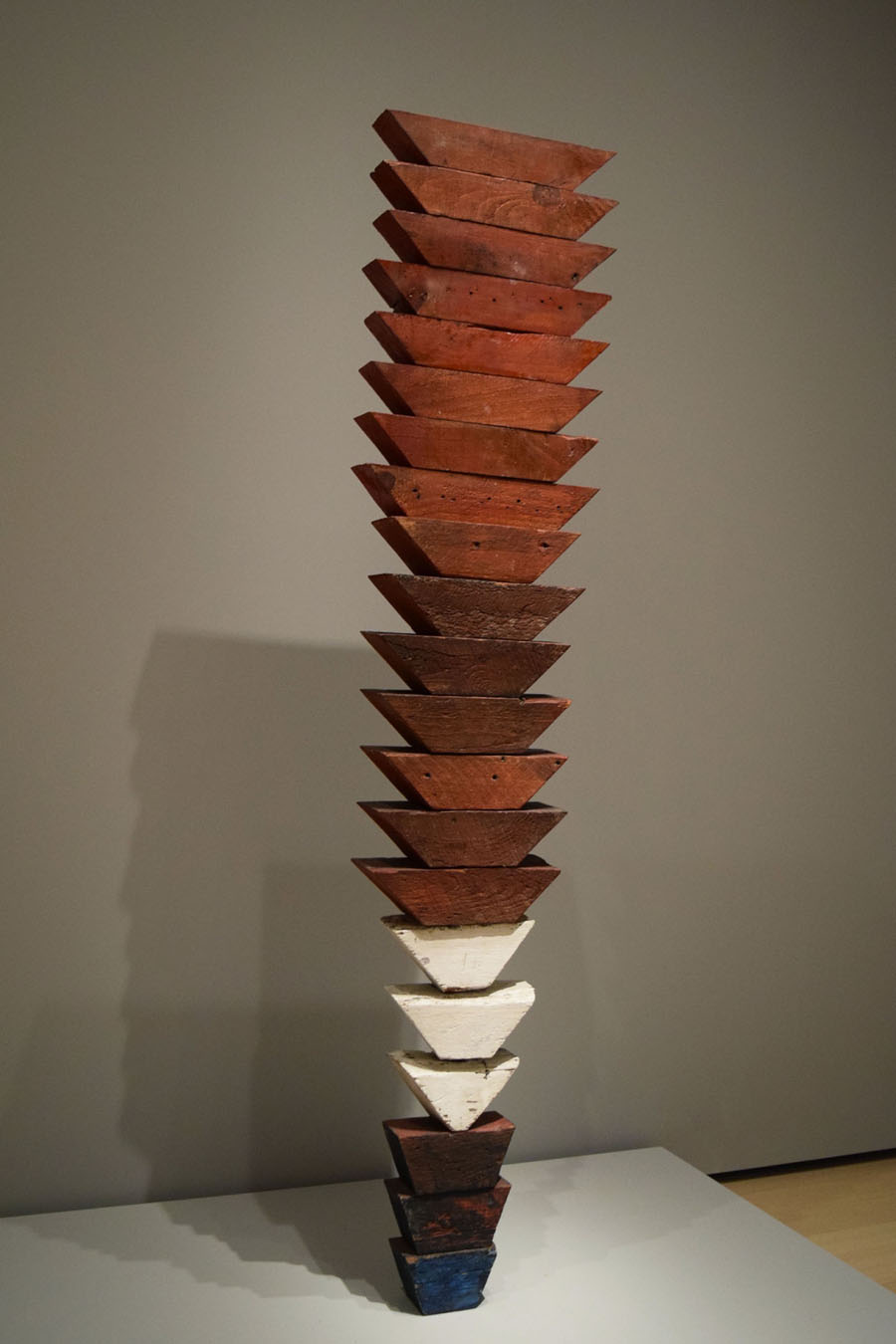
Untitled (The Wedges) (1950). Photo @ www.hyperallergic.com
The artist in New York. The dawn of sculpture.
Now in New York, Bourgeois wastes no time enrolling at the Art Students League and becomes interested in engraving, a technique that would remain in her repertoire til the end of her life. During this time, she researches tri-dimensionality in art and by the mid 1940's has created her first series of wood sculptures, totem poles of highly stylised yet disturbing shapes. 1945 sees the inauguration of her first ever solo exhibition, hosted by the prestigious Bertha Schaeffer Gallery in New York. These are the years when Abstract Impessionism reigned supreme and Bourgeois exhibits alongside its prime movers such as Rothko, de Kooning and Pollock. Nevertheless, her work keeps its distance from the accepted strictures of abstractionism and rather portrays a universe that is far more carnal, explicit and perplexing. Bourgeois' imagination was to remain always on the periphery of schools and tendencies, transcending them with a body of work that was intimate and beguiling.
Following her father's sudden death in 1951, Bourgeois again suffers a deep depression during which she begins to develop her all-encompassing installations that spoke intimately of her memories, lived experiences and traumas. This is also when she starts to attend sessions with a psychoanalyst, coinciding with a period of self-imposed seclusion. In 1964, she comes out of isolation and organises her first solo exhibition for 11 years in which she showcases her latest work both plastic and organic and, for the first time, includes the concept of "lairs", the precursor to her subsequent and spell-binding "Cells".
Destruction and confrontation: facing up to life
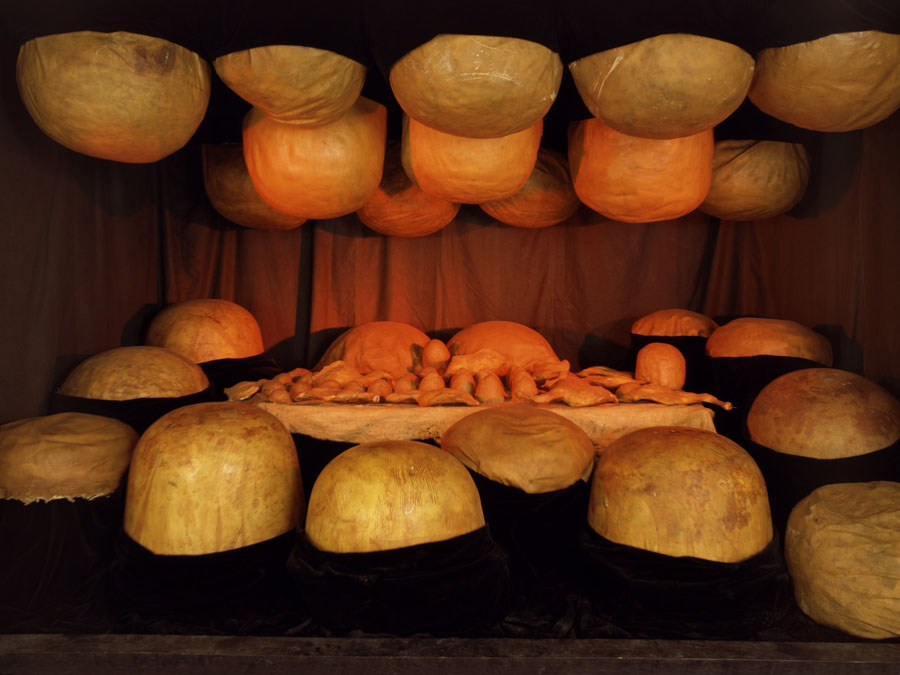
The destruction of the father (1974). Photo @ www.historia-arte.com
Bourgeois's artistic trajectory would appear to broaden and flourish from 1973 onwards. These early years see the first of her installations which revolve around the concept of “lairs” and which she uses as a tool to face up to her personal demons. After her husband's death, she decides to take advantage of the pain and resentment she had been harbouring to create works that bare her all, literally. This is the case with "The destruction of the father" (1974), an impactful installation that seems to show the insides of a vital organ whilst at the same time mimicking a sinister dinner party. The setting, with deliberately arranged organic shapes bathed in red light, is the essence of depredation and even "digestion". It is a direct confrontation with her memory of the relationship she had with a father who forced his family to live with his lover Sadie, the tutor much loved by Bourgeois, and even tried to marry Louise off to one of his friends, something which led to her first suicide attempt.
In her book "Destruction of the father/Reconstruction of the father: writings and interviews (1923-1997)", Bourgeois describes the painful process involved in the installation's creation: "With Destruction of the father, the memories it evoked were so powerful and the job of projecting them outwards so hard that [...] I felt as if it had actually happened. It transformed me, really."
On Confrontation (1978), the performance piece A Banquet: A Fashion Show of Body Parts (1978) and various aspects of the work of Louise Bourgeois
Lairs, cells and spiders. A return from the subconscious
The years of psychoanalysis undertaken by Bourgeois can be seen reflected in much of her output but it is only after 1986 that she starts to create specific pieces, namely "The Cells", to expose the essence of her relationship with social contracts, her lived experiences and the subconscious. These were enclosed installations, each telling its own story and communicating that experience to the minds of whoever enters in. The original one, "Articulated Lair" (1986), was to be the first in a series of some 60 works created using theatrical elements, staging, interactive spaces and, as ever, the presence of emotions. Bourgeois created these scene-settings to connect her work with certain traumatic life events, using them for liberation from them. When the spectator enters inside and experiences the artist's subconscious world, they too come to share her nightmares.
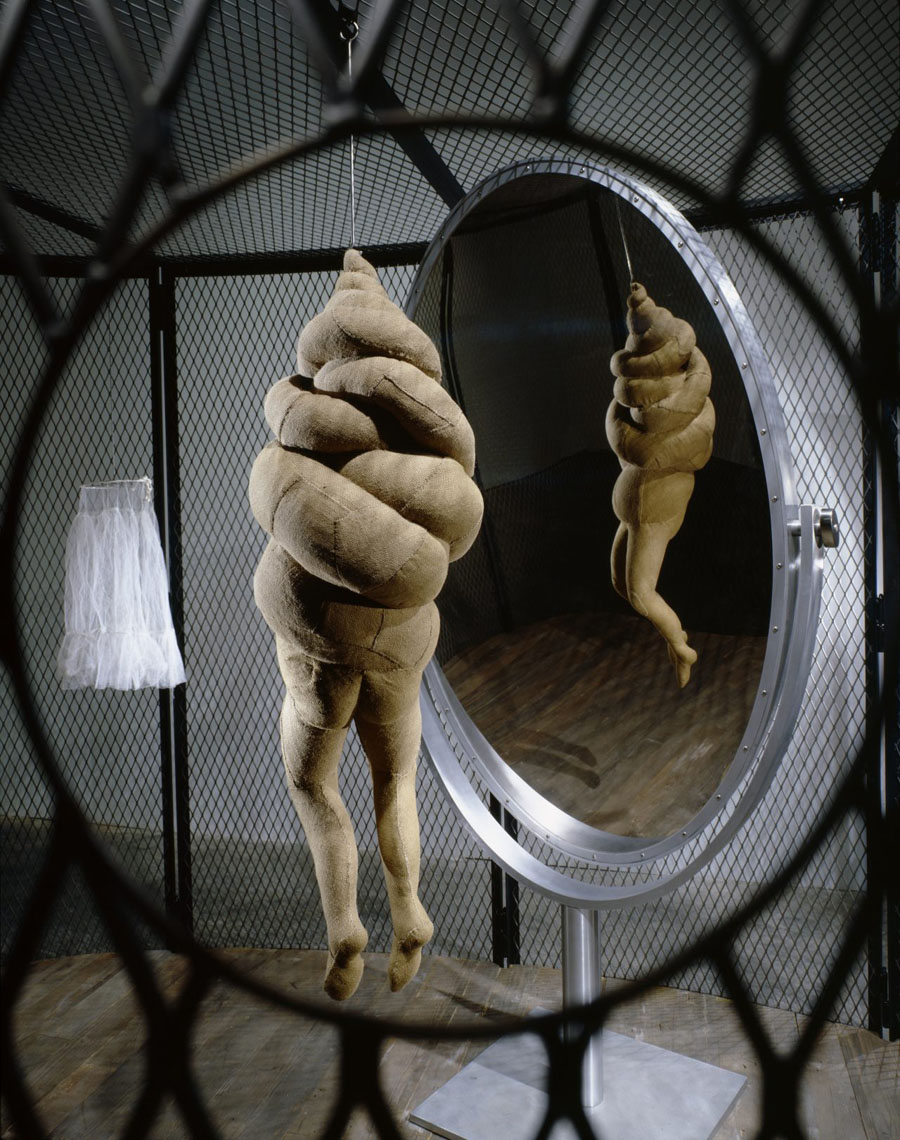
CELL XXVI (2003). Photo @ www.champ-magazine.com
In the mid 1990s, Bourgeois begins to explore another of her obsessions, namely the spider as mother, predator and weaver. Reverting back to her childhood references (spiders and the sick but protective mother), and by now in her eighties, Bourgeois begins to sculpt designs in the form of spiders that are equally terrible and fragile, both victim and destructive force. For her, the spider represented "intelligence, productivity and protection." She creates monumental sculptures (for instance, the famous "Maman" of 1999, on display outside the Guggenheim Museum in Bilbao) and diminutive ones ~ beings who appear almost mythological and whose mission is to reconstruct and restore. “I come from a family of restorers.”, she once said. “The spider is a repairer. If you bash into the web of a spider, she doesn't get mad. She weaves and repairs it."
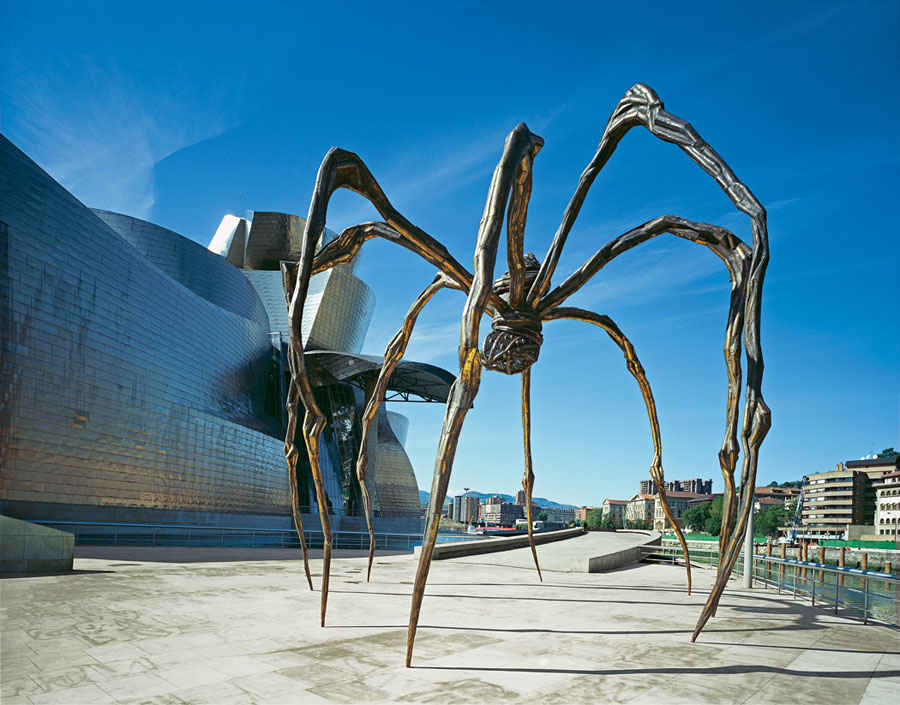
Maman (1999). Photo @ www.guggenheim-bilbao.eus
Louise Bourgeois died in 2010 at the age of 98, never having stopped working or researching until the very last days of her life. Her oeuvre, vast and nuanced, is fundamental to our understanding of artistic evolution in the 20th and 21st centuries.
EXHIBITIONS
Bourgeois saw the inauguration of her first solo exhibition in 1945. From then on, her work was exhibited in many galleries and museums throughout the USA until she finally achieved universal recognition. For decades, her exhibitions have travelled the whole world and attracted thousands of visitors. Still today, they continue to arouse enormous interest, as much amongst specialist critics and art historians as the public.
"Louise Bourgeois" at the Tate Modern, London (2007-2008)
In 2007, London's Tate Modern organised a comprehensive Bourgeois retrospective in collaboration with the Georges Pompidou Centre, Paris. The exhibition then moved on to various museums in the USA.
"HONNI soit QUI mal y pense" at La Casa Encendida, Madrid (2013)
HONNI soit QUI mal y pense (Shame on him who thinks ill of it, referring to her indifference to people's perception and judgement of her work) is the title of a drawing by Bourgeois used to name an exhibition organised by Madrid's La Casa Encendida in 2013. The show focused primarily on the artist's output during the last ten years of her life.
Exhibition curator Danielle Tilkin (in Spanish) describes Bourgeois' work as autobiographical, intensely retrospective, wholly independent of all other schools and movements, engaged in social discourse at any given time, full of black humour, critical distance, internal conflict and reflection on the past and present, reproduction, time and the constant cycles of life.
Bourgeois' assistant Jerry Gorovoy (in English) gives his intimate, in-depth analysis.
Louise Bourgeois (in French) ~ "You have to look at yourself truthfully. Only when you look and like yourself and accept yourself does the silence dissipate and you can then enter into a dialogue. Things don't have to be black or white. Things are much more interesting if they're grey. And if they're subtle. Me, I want to invent something new. I want to invent a sculpture, a script, signs. History is of no interest to me. I'm sick to death of history and tradition."
"Louise Bourgeois. Structures of Existence: The Cells" at the Guggenheim Museum, Bilbao (2016)
In collaboration with the BBVA Foundation, Bilbao's Guggenheim Museum organised a large exhibition of the artist's famous "Cells" (28 installations in total) and of the build-up that lead to her developing these pieces that were so full of her own personal imaginings.
BOOKS
He disappeared in complete silence (1947)
This essential publication compiles the imaginings of a young Louise Bourgeois, both in the plastic and artistic as well as the literary sense. It was created just before her transition to sculpture, a discipline she arrived at via her idiosyncratic wooden "totem poles" and the book's illustrations reflect the research she did prior to this transition. The text, brief and intense, derived from the artist's efforts to disseminate her work and make it better-known on an international level. Although not a success at the time, the book has since come to be considered a reference point fundamental to understanding her work, even though the book wasn't eventually completed until several decades later.
Louis Bourgeois: Destruction of the Father / Reconstruction of the Father (Writings and Interviews, 1923-1997)
“Every day, you have to abandon your past or accept it, and then, if you cannot accept it, you become a sculptor.” This is just one of the many reflections appearing in this fascinating book, which brings together the thoughts and texts Bourgeois collated over seven decades. The volume also includes several interviews she gave that detail her concept of art and and give clues as to the origins of much of her work. One will also find in its pages some of her "pen-thoughts", illustrations that combine text with drawings. It is, without a doubt, essential reading in order to understand Bourgeois's vast and rich body of work.
Structures of existence: The Cells. Louise Bourgeois (2016)
The catalogue for the Guggenheim Bilbao's magnificent exhibition of "The Cells" is an exhaustive study of this suite of sculptures, fundamental pieces in the artist's work. The study includes the complete catalogisation of every installation, as well as keys to the creative process by which Bourgeois came to design and realize each of them. We can also find in its pages a thorough analysis of the concepts that form the basis of her work, namely space and memory, conscious and subconscious thinking, the body and architecture.
(Translated from the Spanish by Shauna Devlin)
- Louise Bourgeois: biografía, obras y exposiciones - - Alejandra de Argos -
- Details
- Written by Marta Sánchez
As well as being one of today's most highly regarded artists (something that, incidentally, would have greatly annoyed him), Sigmar Polke is the personification of the versatile, nonconformist artist creator. His work runs the gamut of all the styles present in contemporary art, from Realism to Pop Art and from Arte Povera to pieces in whose creation a deliberate happenchance intervenes. However, what makes Polke one of the most interesting artists of the last four decades is that he never limited himself to just one single material or product (oil, acrylic, collage ....) on whichever mount or frame he chose to display them. In his workshop, he was given not only to mixing it up with all kinds of media but also to combining many of the components of 20th century culture.
As well as being one of today's most highly regarded artists (something that, incidentally, would have greatly annoyed him), Sigmar Polke is the personification of the versatile, nonconformist artist creator. His work runs the gamut of all the styles present in contemporary art, from Realism to Pop Art and from Arte Povera to pieces in whose creation a deliberate happenchance intervenes.
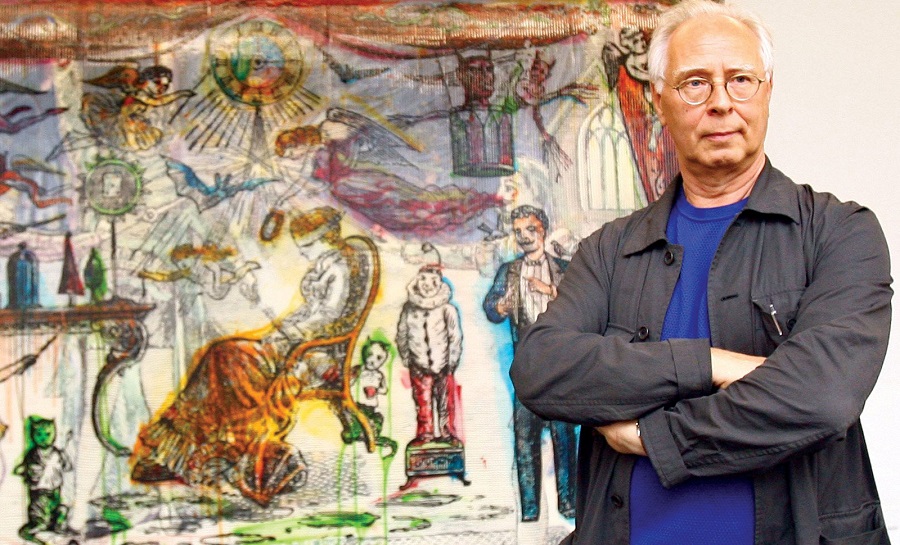
Sigmar Polke. Fredrik Von Erichsen—dpa/Landov - Encyclopædia Britannica Online.
However, what makes Polke one of the most interesting artists of the last four decades is that he never limited himself to just one single material or product (oil, acrylic, collage ....) on whichever mount or frame he chose to display them. In his workshop, he was given not only to mixing it up with all kinds of media but also to combining many of the components of 20th century culture. As a result, his work is full of nuances, and oftentimes poetry as an added ingredient, along with his very firm commitment to social commentary verging on whistleblowing.
From stained glass window apprenticeship to the Düsseldorf Arts Academy

Stained glass window by Sigmar Polke. Grossmünster Church. Photo: Roland zh
Polke was born in Silesia, now part of Poland, in 1941. His family were forced to flee to East Germany after his homeland's defeat in World War II and again in 1953, this time into neighbouring West Germany. With his family now settled in Düsseldorf, Polke began his artistic career learning the techniques of staining glass windows but soon exchanged this for Fine Arts studies at the Düsseldorf Arts Academy. Sometimes it's of the essence to find yourself in just the right place at just the right time which is precisely what happened in Polke's case as he was able to forge his talent under the tutorship, and influence, of professors such as Joseph Beuys, Karl Otto Götz and Gerhard Hoehme.
By 1963, Polke had already allied himself with several classmates and friends, amongst them none other than Gerhard Richter, to launch his first ever collective exhibition in one of the city's empty slaughterhouses. It was the starting point for both their careers and they would soon conceptualize something that would from then on be definitively linked to their art: Capital Realism.
Capital Realism, alquemy and provocation
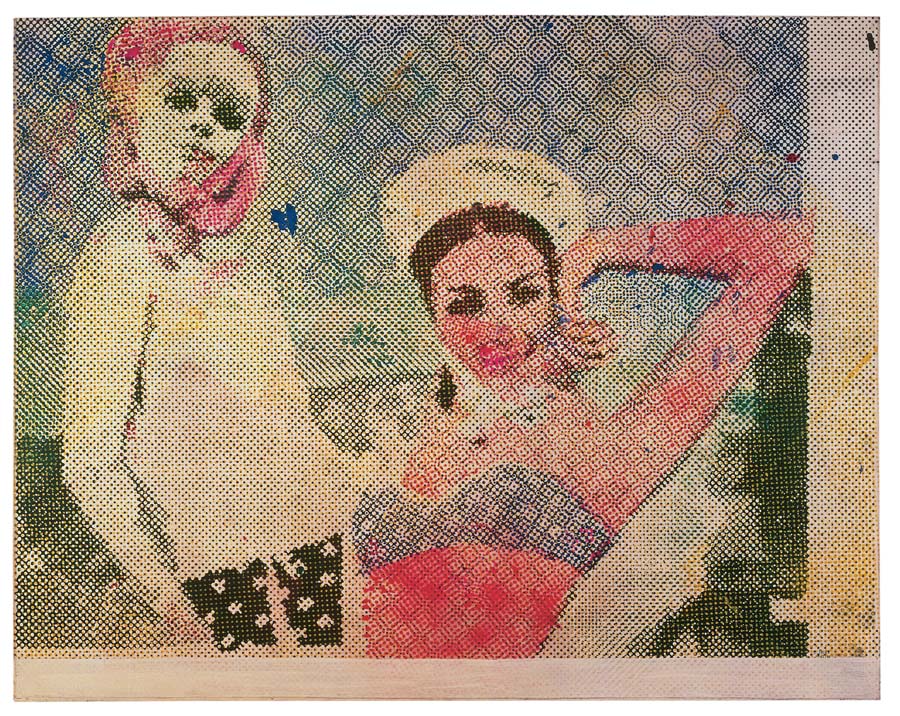
Freundinnen (Friends) 1964-65 © The Estate of Sigmar Polke / DACS, London / VG Bild-Kunst, Bonn. www.alexkittle.com
Capitalist Realism was inspired by Socialist Realism, the "official" art movement of Lenin's USSR and Mao's China. During these years, Polke intelligently mixed parameters inherited from New American art (heavily influenced by Warhol and Lichtenstein) with a stale realism riddled with stereotypes and symbols, like the swastika that was then banned in Germany. The result was a series of works denouncing not only Germany's absorption into a consumerist and capitalist maelstrom but also the stagnation, totalitarianism and omnipresence of the governments ruling the Communist bloc. This period is marked by iconic works such as "Freundinnen" (Friends) from 1965.
Polke was also known as the alquemist. In his studio, he mixed materials, media and products to give new meaning to reality and to art. These works, with formats ranging in scale from the smallest to the most monumental, differ according to who is looking at them, from which angle or distance and even the mood they happen to be in at the time. But Polke's alchemist zeal was not limited to just the purely technical field. As well as blending seemingly impossible products with pigments, from the 60's on he began to merge political and critical elements into his creative output, these layered with the German sarcastic tradition inherited from artists like George Grosz.
Buyer, I dare you
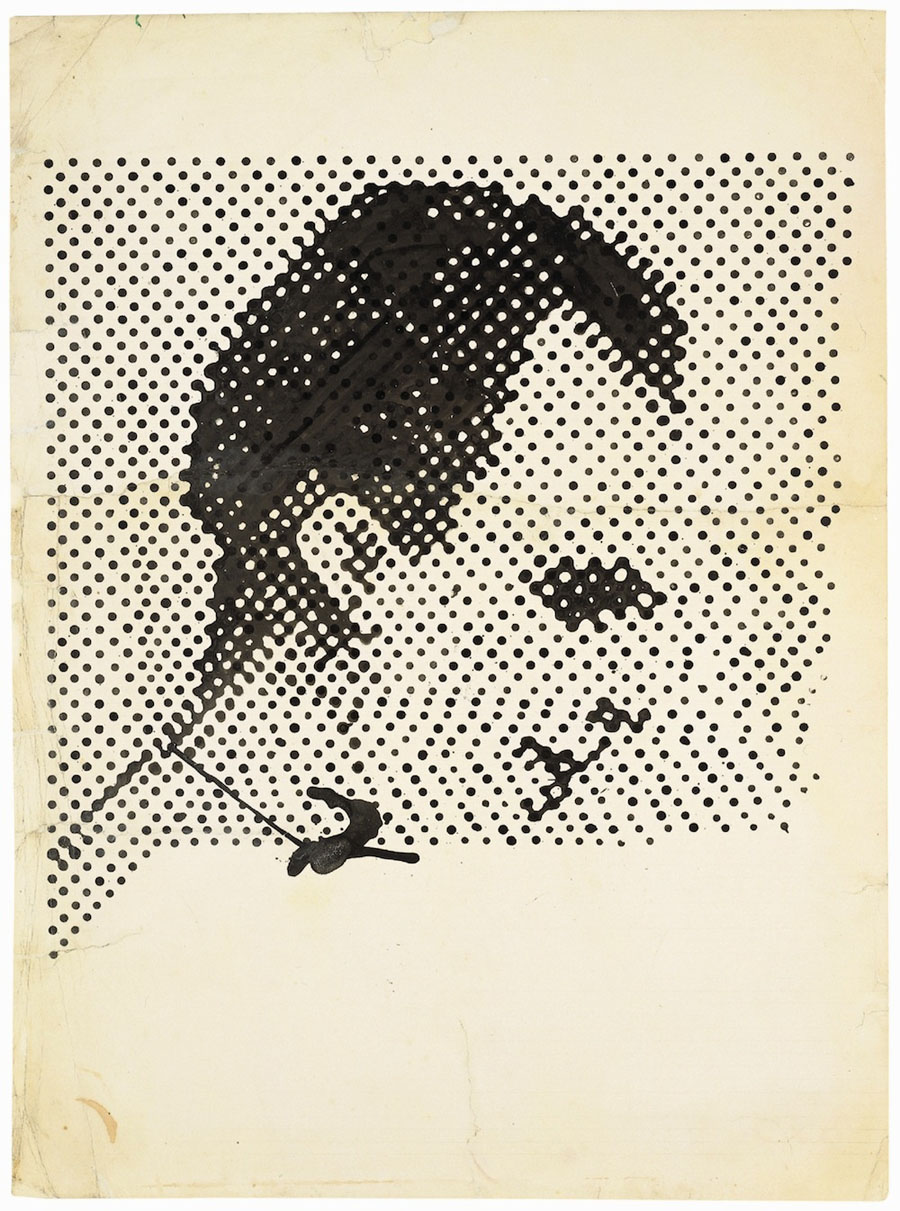
Sigmar Polke Raster Drawing (Portrait of Lee Harvey Oswald) 1963 © The Estate of Sigmar Polke / DACS, London / VG Bild-Kunst, Bonn. Tate UK
This type of experimentation gave rise to pieces full of political intent. During this time, Polke produced such provocative works as his famous portrait of Lee Harvey Oswald, painted in 1963. After seeing Warhol's well-known prints of the multiplied faces of Marilyn Monroe and Jackie Kennedy, Polke decided to do the same with one of the then most hated people in America: the alleged murderer of President Kennedy. His attitude was akin to a challenge to society, a way of saying to the world: "Here you are then. Buy it if you dare".
The LSD years

Sigmar Polke. Alice im Wunderland, 1972. Private Collection. Photo: Wolfgang Morell
© The Estate of Sigmar Polke by SIAE 2016. Eigth Art Projects.
The 70's were for Polke, as for so many other artists, a decade of experimentation. He went to live on a farm commune where he dabbled in drugs like LSD and magic mushrooms, in addition to contributing to the creation of collective artworks. They are fruitful years in terms of his creativity. Polke produces some quite powerful works based on mixing and overlapping new materials. And at this time, they also match the artist's photographs that he was manipulating using chemical agents in a seeming attempt to portray the human mind as altered by drugs.
In 1972, Polke takes part in the iconic documenta 5 in Kassel, Germany and from that moment on, his work achieved a worldwide popularity that continues to this day. The 70's also see him travelling extensively to the likes of Afghanistan and the Lebanon where his camera captured moments that he would later transform into works of art.
{youtube}Coia8F64KjI|900|506{/youtube}
The journalist Sarfraz Manzoor conducts an exhaustive review of the retrospective exhibition Alibis: Sigmar Polke (1963-2010) at the Tate Modern, London
Rupture and rebirth: Art as a reflection of a society in turmoil

Sigmar Polke. This is how you sit correctly (after Goya), 1982. Private collection, Baden Baden. Image viewable at www.artchive.com.
Already by now a world-renowned artist, at the start of the 80's Polke is rethinking his art and decides to break with all that went before in order to start again from scratch. The experimentation in his art becomes more troubling, explosive and radical. Over this period, he uses disturbing and even dangerous products to carry out his works: meteorite dust, arsenic-based toxic paint, uranium, ..... Polke draws on artists of the past who portrayed the horrors of war and human behaviour. Among them, Goya's work exerts a particular attraction and the Spanish artist's imagery appears in works like "This is how you sit correctly (after Goya)" from 1982.
Meanwhile, against the backdrop of the Cold War and the tense relations between world superpowers, the unstable political scene was giving much cause for alarm. This state of affairs can be seen reflected in Polke's work depicting a changing, nightmarish world during these years.
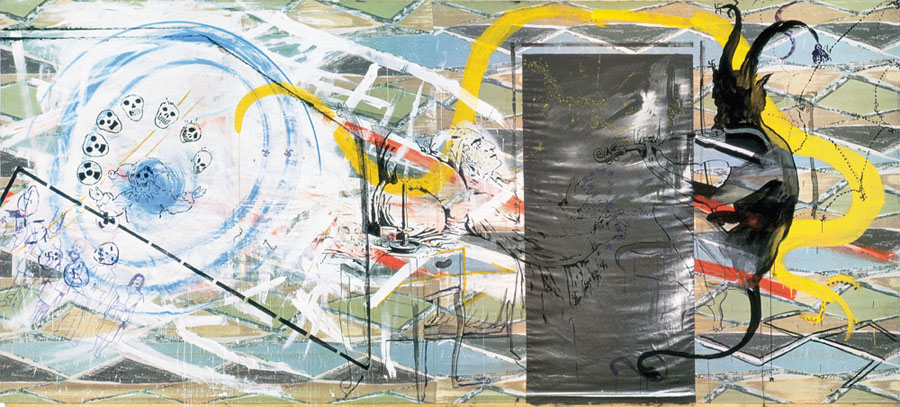
Paganini, 1982. Saatchi Gallery, London
In his later decades, Polke's work continued to evolve along these same lines. Without ever abandoning his references to Germany's past, evident in his portraits of young Nazis or the swastikas hidden in works such as "Paganini" from 1982, his continuous experiments with products, materials, transparencies, projections and graphics generated dozens of masterpieces, works that now constitute one of the most compact, coherent, shocking and provocative artistic trajectories of 20th century art history.
Notable exhibitions
Following the 1972 documenta 5 exposure that catapulted him to fame, Polke began a frequent chain of joint and individual exhibitions. Initially, his work was exhibited in German galleries (and later museums) which then moved on to cities such as Paris, New York, Washington and London. Polke died in 2010 but the world's greatest museums still continue to mount exhibitions to showcase the magnitude and diversity of his oeuvre.
- New Works - Sigmar Polke. Museum of Modern Art of the Ville de París, 1988. One of the first exhibitions outside Germany which marked the beginning of a worldwide dissemination of his work.
- The Three Lies of Painting - Sigmar Polke. Art and Exhibition Hall, Bonn, 1997. This exhibition subsequently moved to the Berlin National Gallery for Contemporary Art at Hamburger Bahnhof (1997-1998). It was based on a work of the same name from 1994.
- Retrospective. San Francisco Museum of Modern Art (SFMoMA), 1990. This was Polke's first ever retrospective in the Unites States. The exhibition subsequently moved to the Hirshhorn Museum and Sculpture Garden, Smithsonian Institution (Washington), the Museum of Contemporary Art (Chicago) and the Brooklyn Museum (New York).
- Sigmar Polke - Photoworks. When Pictures Vanish. The Museum of Contemporary Art, Los Angeles (1995). This exhibition was a compilation of the artist's photographs taken between 1960 and 1995.
- Retrospective - Sigmar Polke. Museum Frieder Burda - Baden Baden (Germany), 2007.
{youtube}_m4eHWc28io&t=65s|900|506{/youtube}
- Alibis - Sigmar Polke: 1963 – 2010. MoMA (New York). Later, Tate Modern (London), 2014-15.
{youtube}F_jEzpQJygw&t=261s|900|550{/youtube}
- Sigmar Polke - Palazzo Grassi, Venice, 2016.
{youtube}lb9k5EBccsE|900|506{/youtube}
- Sigmar Polke - Music from an Unknown Source. Museum of Modern Art, Mexico, 2017.
{youtube}LbA4MlDhdZg|900|506{/youtube}
(Translated from the Spanish by Shauna Devlin)
- Sigmar Polke: Biography, Works and Exhibitions - - Alejandra de Argos -
- Details
- Written by Marta Sánchez
At the tender age of 10, a Japanese girl called Yayoi Kusama encountered the worlds of colour, sculpture and the modelling arts for the very first time. Enamoured ever since with polka dots, she began creating works of art in which fantasy and reality coexisted in settings where nothing was what it seemed: portraits of her mother obliterated by dots, for instance. These were works intended to reflect the disturbing hallucinations that her own mind was producing. They were the solution Kusama came up with to counteract the effects of her mental disorder. She simply painted what she saw. That same little girl, Yayoi Kusama, is still alive and well in her Infinite Rooms, in those ever-present polka dots and in those flowers on the borderline between heaven and hell.
At the tender age of 10, a Japanese girl called Yayoi Kusama encountered the worlds of colour, sculpture and the modelling arts for the very first time. Enamoured ever since with polka dots, she began creating works of art in which fantasy and reality coexisted in settings where nothing was what it seemed: portraits of her mother obliterated by dots, for instance. These were works intended to reflect the disturbing hallucinations that her own mind was producing. They were the solution Kusama came up with to counteract the effects of her mental disorder. She simply painted what she saw.
That same little girl, Yayoi Kusama, is still alive and well in her Infinite Rooms, in those ever-present polka dots and in those flowers on the borderline between heaven and hell. The artistic world of one of our most fascinating contemporary artists has its origin in the nightmares that have plagued her all her life. But as she matured into adulthood, she found the means by which to portray and display them beautifully to an adoring audience.
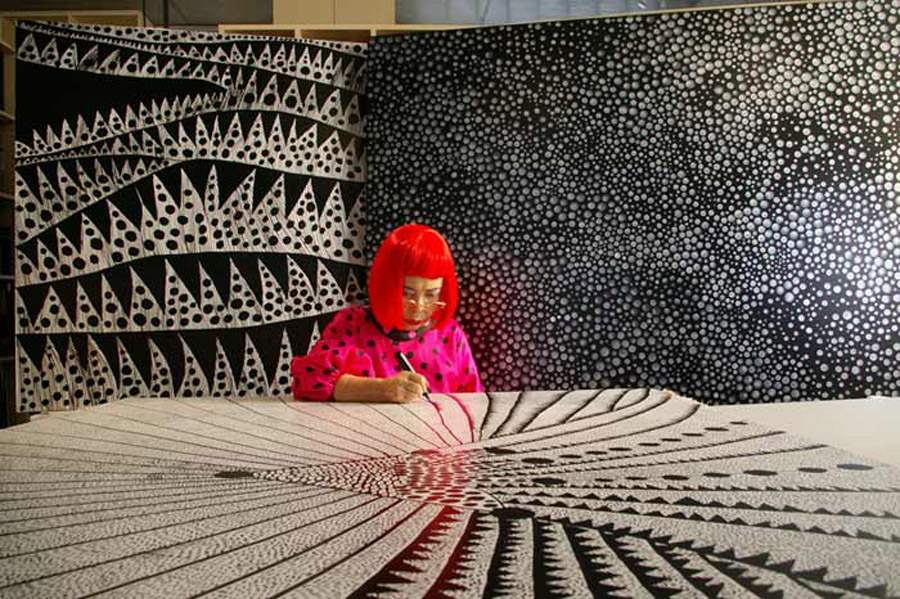
Yayoi Kusama at work. Photo: Vagner Carvalheiro
"My art is an expression of my life, particularly my mental illness." Yayoi Kusama
Born in Matsumoto (Japan) in 1929, her formative years were played out in a misogynistic society where women had little or no say and even less so in the complex field of the arts. In 1957, at the age of 28, she moved to New York to seek out a new way to express the artistic maelstrom that nestled in her mind and spirit. Neither the overwhelmingly robust American artistic world nor its male bias prevented her from becoming one of the most 'bubbly', innovative and active art creators of her time (and the times that would follow). In the form of installations, "happenings", oversize canvasses and performances, the work of Yayoi Kusama since then has displayed a diversity and an anxious curiosity that knows no barriers and no bounds.
New York (1957-1973)
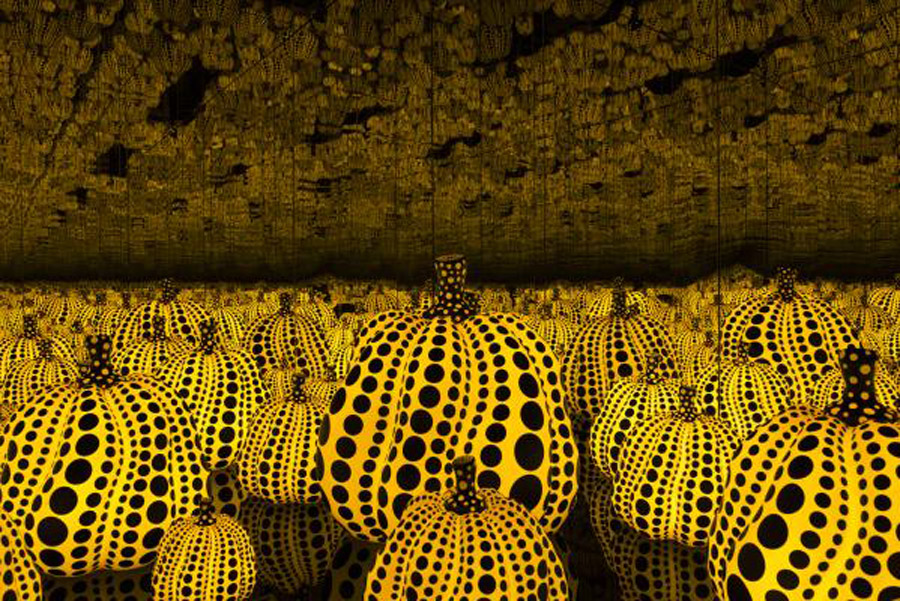
All the eternal love I have for the pumpkins (2016) – Dallas Museum of Art
In New York, she rubs shoulders with artists of renown such as Andy Warhol and Donald Judd. She becomes part of the Pop Art explosion and the unfettered creativity of the '60s and '70s with its hugely 'influencing' installations of light, colour and curves. This is also the time of her "soft sculptures", montages of colourfully-dotted, stuffed or quilted fabrics that reveal her deep-seated fear (as she herself attested) of sexuality and penetration.
By the end of the '60s, a powerful socio-cultural movement dominating the whole American art scene becomes just too much for Kusama's spirit and wellbeing. She abandons it in favour of instead creating artworks as 'happenings', anti-war demonstrations and fashion. She also begins to make films, somewhere in between cinematography, self-portraiture and art, amongst which "Kusama's Self-Obliteration" (1967) stands out. The film won numerous awards and was a giant step towards worldwide recognition for an artist as innovative as she is fascinating.
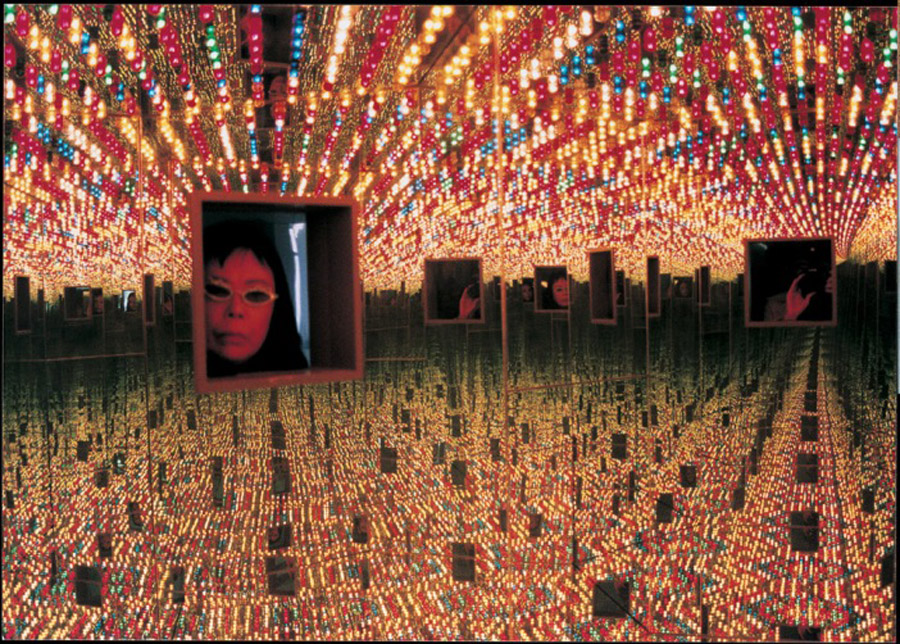
Infinity Mirrored Room – Love Forever 1996. Photo: Le Consortium, Dijon © André Morin and © Yayoi Kusama . Tate Modern, London
1973 is the year of Kusama's return to her native Japan. Her talent then truly reveals itself in all its multiple facets: from the already established plastic arts to the newly discovered literary ones. In 1983, her novel "The Hustler's Grotto of Christopher Street" wins the 10th Yasei Jidai Literary Award for First-Time Authors. The '80s see her first major exhibitions worldwide, including the Museum of Fine Arts in Calais (France), as well as New York and London. These exhibits culminate in her presence at the 1993 Venice Biennale where "Narcissus Garden" (heavily influenced and promoted by the artist Lucio Fontana) spoke to the spectator of the self-proclaimed and lifelong history of narcissism of its creator using as language her passion for flowers, mirrors and infinite, spherical shapes.
Venice Biennale. Narcissus Garden.
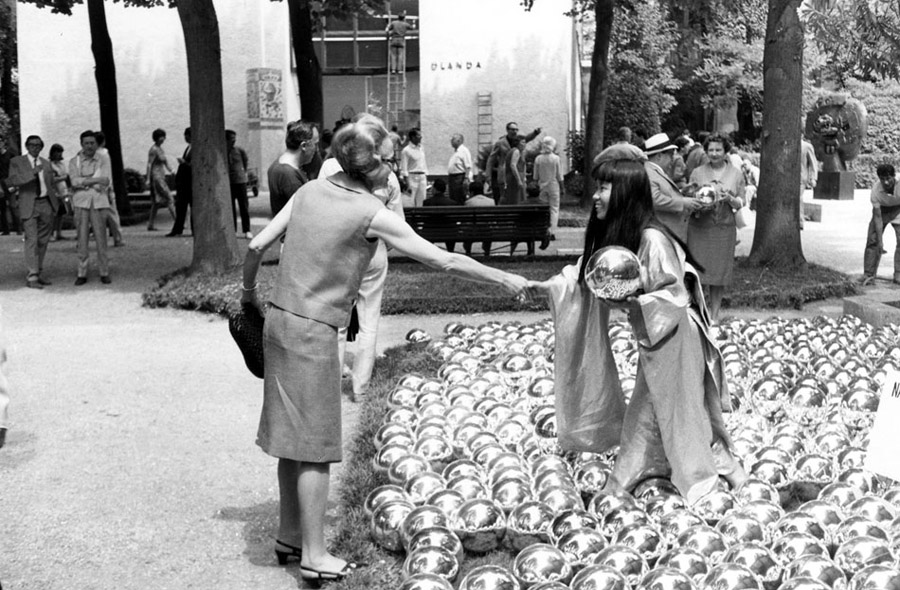
Yayoi Kusama in her Narcissus Garden installation, created for the 1993 Venice Biennale. Photo © Khan Academy
Although Kusama was not officially invited to exhibit, the moral and financial support afforded her by Lucio Fontana (as well as permission from the chairman of the Biennale Committee himself) meant she could stage her installation on the lawn outside the Italian Pavilion. It consisted of 1500 mirrored globes the size of crystal balls, tightly arranged to reflect only the viewer's image. Kusama placed two signs beside it: “Narcissus Garden, Kusama” and “Your Narcissium (sic) For Sale”. Wearing a gold kimono with silver sash, she sold off the mirror balls to passers-by for a dollar a piece, and each was accompanied by a flyer with flattering comments about her work. In this way, the work revealed itself to be a steely criticism of the commercialisation of art and its status as merchandise. After this, Kusama began further work on the creation of outdoor installations and sculptures.
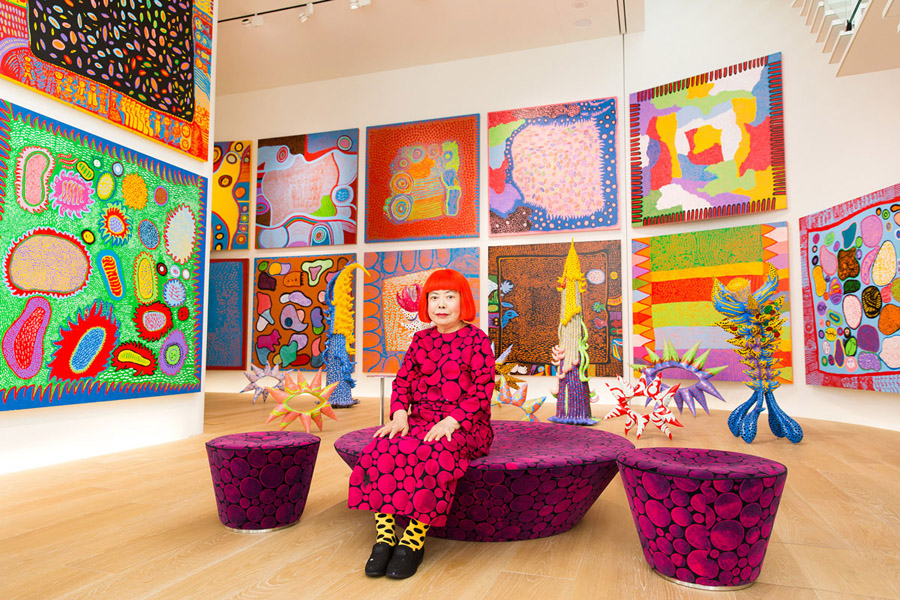
Yayoi Kusama with recent works, Hirshorn Museum, 2016. Photo: Tomoaki Makino. Courtesy of the artist © Yayoi Kusama.
Now a world-renowned artist whose work has been recreated and exhibited internationally in the most prestigious museums and galleries, Yayoi Kusama currently lives in a private mental health facility of her own free will. She continues to work from her nearby studio and continues to dialogue with her old nightmares, the primal origin of her ever-restless and always dynamic work. Then, in September 2017, and as a fitting culmination to her career, The Kusama Museum (Tokyo) opened its doors and its five floors entirely dedicated to the oeuvre of this fascinating creator.
{youtube}rRZR3nsiIeA|900|506{/youtube}
Yayoi Kusama talks about her life and her work in this feature from Tate Youtube channel
A quirky, troubled, coherent oeuvre
If anything were to characterise the work of Kusama, it would undoubtedly be its intensity. This prolific and innovative artist could almost be said to imbue her creations with 'suffering'. Since her very first pieces, when a kind of mental hallucination was already both palpable and inseparable from the aesthetic, Kusama's works have captured the spectator and propelled them into a stream of passions.
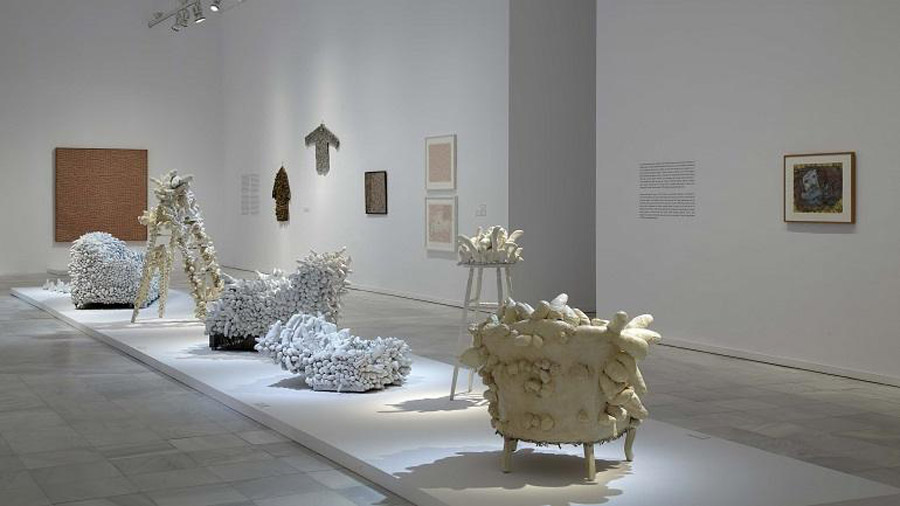
Accumulation Sculptures. Reina Sofia Museum, Madrid Museo Reina Sofía
Accumulation Sculptures
In addition to the celebrated New York performances and "happenings" of the 60s and 70s, Kusama was at the same time creating her famous Accumulation Sculptures in which she abandoned paint as her only medium, instead merging it with three-dimensional shapes. Titled “Soft Sculptures”, they had clear phallic and sexual overtones that became emblematic of her work.
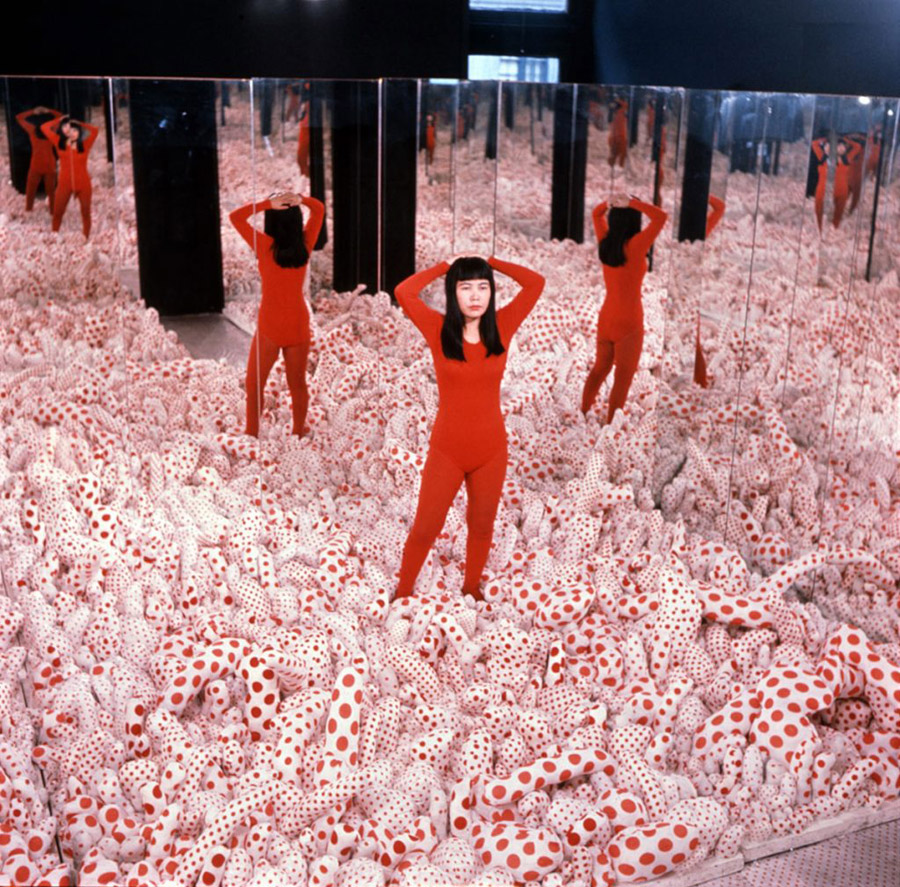
Infinity Mirrored Room – Phalli's Field (1965), Hirshorn Museum. Photo © Yayoi Kusama.
Infinity Mirrored Rooms. But if anything about the artist's work still incites passion (and one has only to remember the Spring 2017 exhibition at the Hirshhorn Museum in Washington that broke all-time visitor records), it is her Infinity Mirrored Rooms. Kusama began work on this series in the 60s, a series made up of different rooms, each with floor-to-ceiling mirrored walls, shapes and lights creating an ambience intended to transmit certain sensations and feelings. They were places of peace but also of anxiety. Of colour but also austerity. Of welcome and of terror. And this because all of the sensations that form part of Kusama's life become ours, too, as we literally enter into her works.
Yayoi Kusama, a legend in contemporary art, is still today painting the stuff of her dreams and, of course, her nightmares: as awful, as awesome and as fascinating as all of ours.
Further reading:
- Yayoi Kusama. Infinity Mirrors
- Infinity Net: The Autobiography of Yayoi Kusama
- Yayoi Kusama. Revised And Expanded Edition
- Women In Art. 50 Fearless Creatives Who Inspired the World
(Translated from the Spanish by Shauna Devlin)
- Yayoi Kusama: Biography, Works and Exhibitions - - Alejandra de Argos -
- Details
- Written by Kilian Lavernia
At first glance, the work of Marina Abramović (Belgrade, 1946) would appear to conform to that hackneyed old saying that the best art is always about the self. However, as with so many other clichés about contemporary art, this serves only to limit the scope, richness and originality of this particular artist who, since day one over four decades ago, has made her own human body into a vital space for experimentation, her raw materials and a battlefield, even. Abramović herself is, effectively, the work itself. But only in as much as one must then incorporate this variable into a more complex equation, after pioneering reflection on the ultimate meaning of her performances which, after forty years of creative exploration, has consolidated her place and her identity within postmodern discourse.
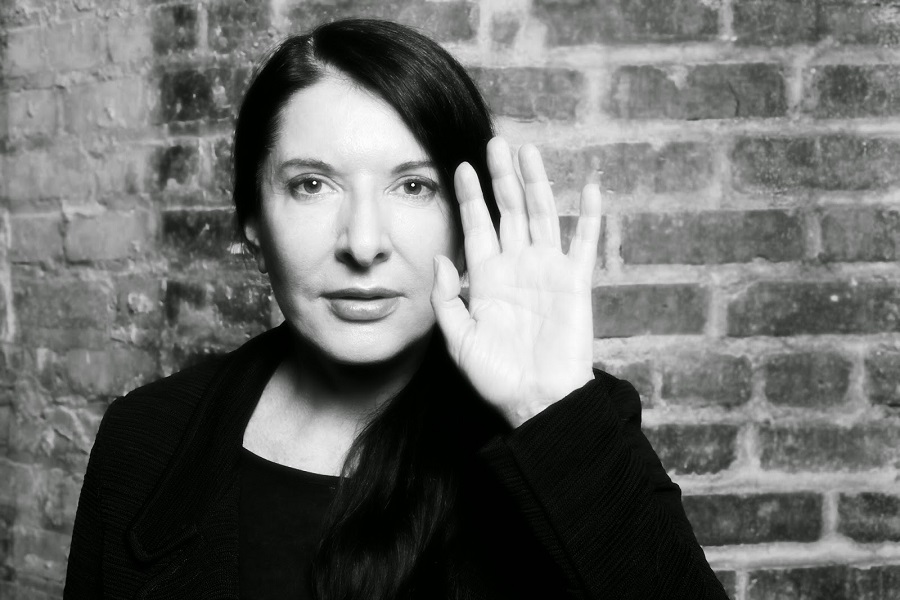
Photo portrait of Marina Abramović by David Leyes
At first glance, the work of Marina Abramović (Belgrade, 1946) would appear to conform to that hackneyed old saying that the best art is always about the self. However, as with so many other clichés about contemporary art, this serves only to limit the scope, richness and originality of this particular artist who, since day one over four decades ago, has made her own human body into a vital space for experimentation, her raw materials and a battlefield, even.

Photo portrait of Marina Abramović. Image available at www.cronicasyversiones.com
Abramović herself is, effectively, the work itself. But only in as much as one must then incorporate this variable into a more complex equation, after pioneering reflection on the ultimate meaning of her performances which, after forty years of creative exploration, has consolidated her place and her identity within postmodern discourse. As a form of visual art, of art as action, her performances are both experiments in trying to identify and transgress limits of control over one's own body as well as, in regard to the relationship between public and performer, searching questions about the taxonomic boundaries in traditional art, based on the divide that exists between these two: subject and object. If we understand her body as simultaneously both subject and medium, Abramović's experimental probing breaks away from the ideas of stasis and temporality inherent in our usual aesthetic understanding, and thereby expands the dialogical, structural boundaries of any piece of art.
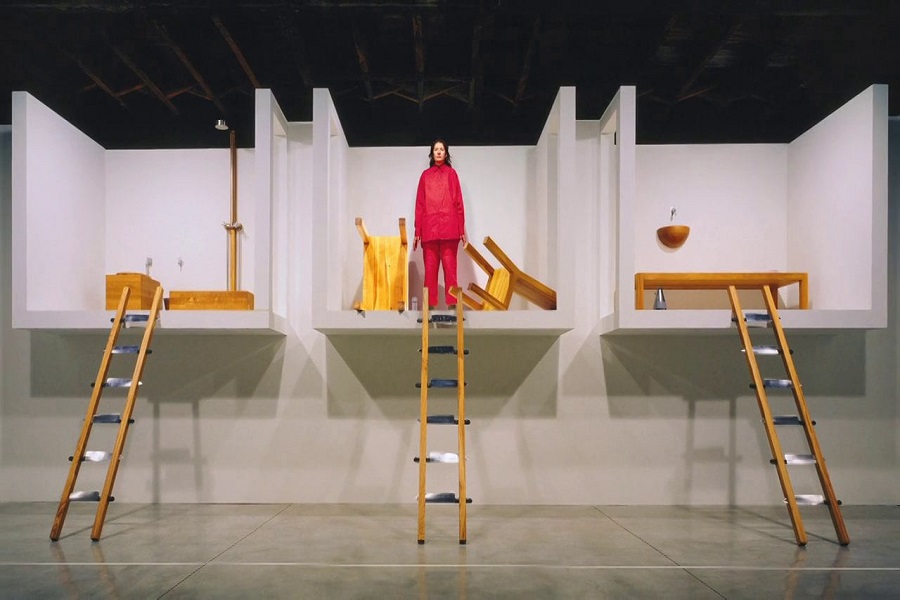
Still from A House with the Ocean View (2002). Image available at vimeo.com/72468884
The Serbian artist's performances involve an immediate and emotional exchange of energy with the public, as she intends, making them that last piece of the equation without which the transformative experience of art would be incomplete and in vain. On this matter, she has commented: "I could never give a private performance at home because I have no audience there [...] The bigger the audience, the better the performance and the more energy runs through the space. The audience should take an historic step and really connect with the object."
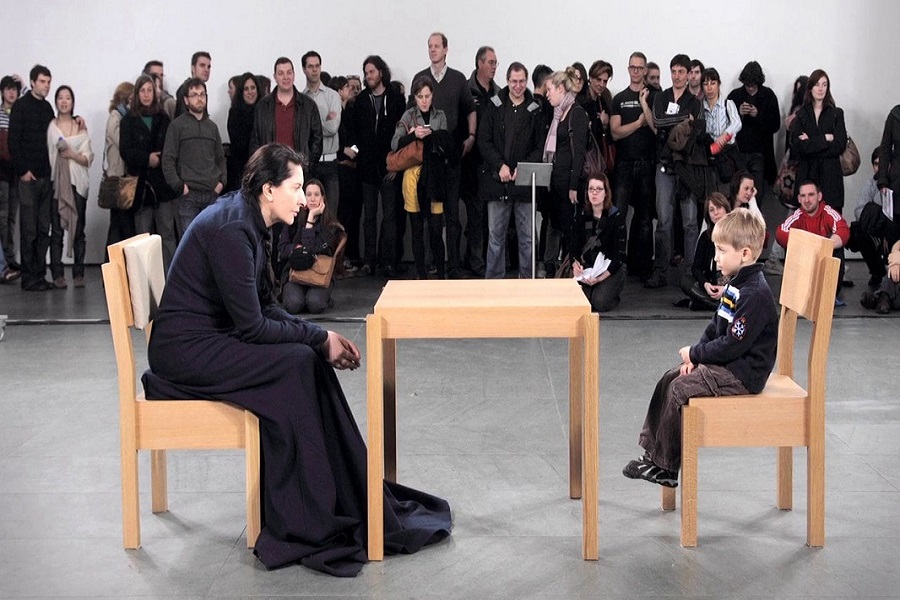
The artist is present (2010). Image available from the Marina Abramović Institute website: www.mai.art
From the very beginning, Abramović's output has been daring, provocative and transgressive. She began her artistic studies in the mid 60's in her birthplace of Belgrade, continued and finished them in Croatia, returning to teach Fine Art in Serbia in 1973. Ever since her debut with the well-known Rhythm (1973/74) series, framed as a bold, hazardous exploration of Body Art, the young Abramović was testing, on one hand, the body's limits in the face of physical pain, suffering, self-harm and, on the other, the moral resistance of the public to feel her world through those very personal experiences of her female body. It was a work in, on and of her body.
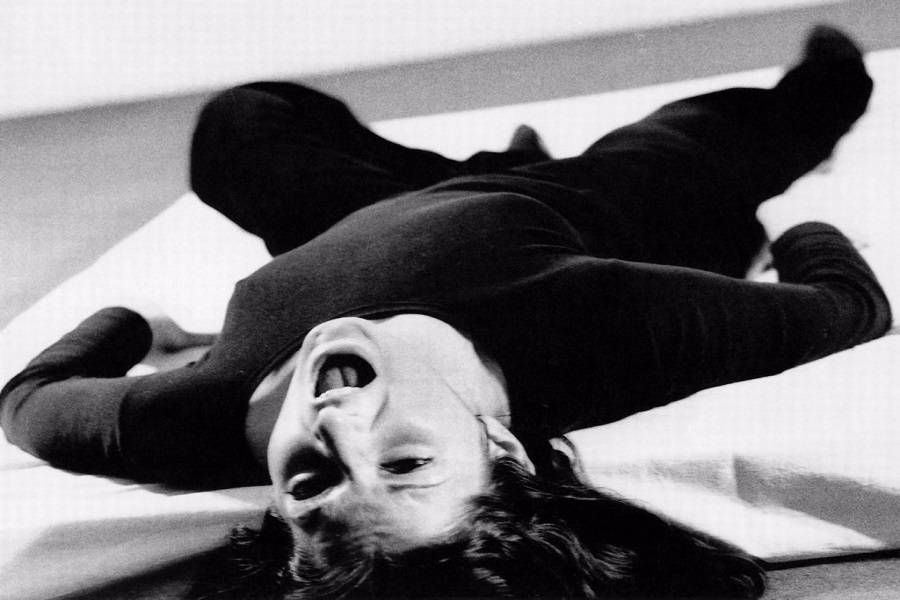
Rhythm 2 (1974). Image available at marinaabramovic.blogspot.com
The different variations of Rhythm used embodiment to reflect on universal themes such as death, pain, sorrow, time, the limits of consciousness and unconsciousness, not to mention the behavioural patterns of the mind. Likewise, in Rhythm 2, she experimented with the varying states of lucidity and loss of corporal control produced by the ingestion of a range of different pills. In Rhythm 0, one of her most emblematic performances, Abramović literally put herself at the public's disposition. Along with 72 different instruments of different uses - from pencil to polaroid camera to perfume as well as knives, whips, chains and a loaded gun - she offered up her body for a no-holds-barred, unscripted, interactive show with her public.
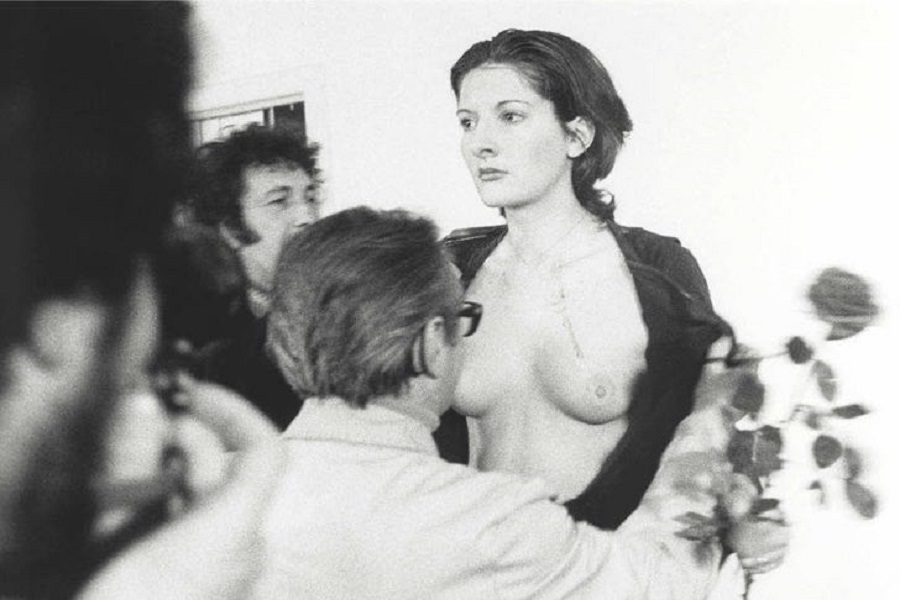
Rythm 0. Image available at www.upsocl.com
The visitors were invited to choose any object and use it on her in whichever way seemed most interesting to them. And so began what was intended as a reflection on trust and the social contract and ended up being a palpable demonstration of Man's natural inclination towards violence. "What I learnt was that, if you allow the public to decide, they could kill you. I felt really attacked: they cut my clothes off, they scraped rose thorns across my stomach, one person held the gun to my head before another took it off him." Abramović's silence and lack of reaction meant that the violence escalated quickly and dramatically. "After exactly six hours, as planned I got up and started walking towards the public. They all scarpered, avoiding a real-life confrontation."
Rhythm 0 (1974). Image available at ourpursuitofart.blogspot.com
The subsequent evolution in Abramović's work owes much to her character trait of inclusivity and her willingness to be ever open to others. In a certain way, it's in her nature to have infinite possibilities. As opposed to the unitary and bourgeois concept of one single artistic identity, namely the definition of the artist-individual focused on each work as a solitary project, Abramović invariably challenges herself to build up emotional interactions with second parties and with herself as producer/director.
Proof of this came at the end of the 70's when her artistic output centred around an unclassifiable dual manifestation of her art in productive and emotional conjunction with her lover, the German artist and photographer Uwe Laysiepen, better known as Ulay. In a series entitled The Other, Abramović and Ulay performed numerous performance works as a duo in which their bodies – always synchronised, dressed (or undressed) identically and with similar behavioural patterns – created additional ways in which to interact with the public. Based on a professional and sentimental relationship of absolute trust, both liked to speak of an "adrogynous unity" whose actions personified the limits of interpersonal relationships, their effect on the "I", the ego and artistic personae. This is perfectly illustrated in Relation in Time (1977), one of their earliest joint perfomances, where this hermaphroditic union is symbolised by their tightly interwoven hair.
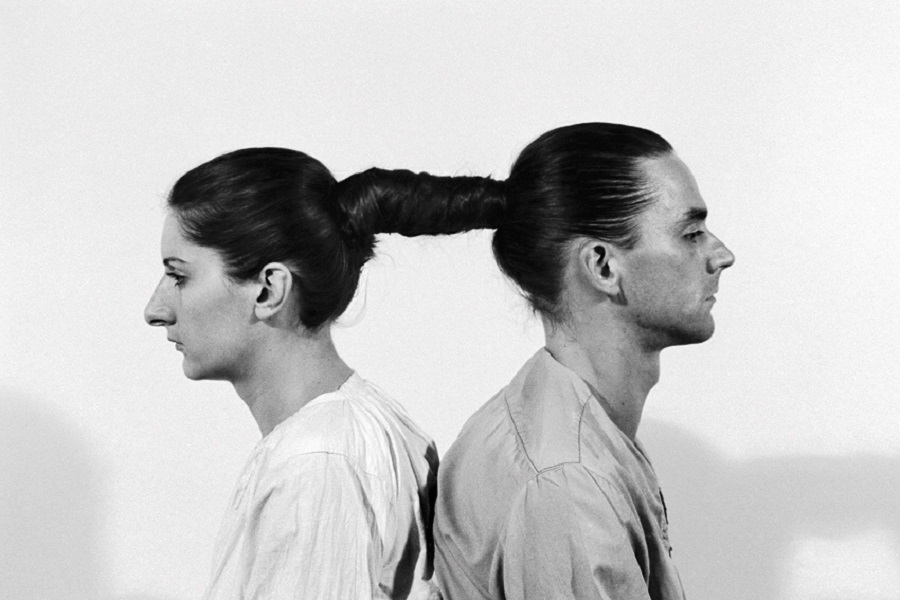
Relation in Time (1977). Image available at pomeranz-collection.com
Their collaboration produced further and riskier (and indeed risqué) projects such as Imponderabilia (1977), where Abramović and Ulay stood facing each other, completely unclothed, in a narrow passageway at the entrance to the museum, thereby obliging visitors to squeeze between them and brush up against their naked bodies.
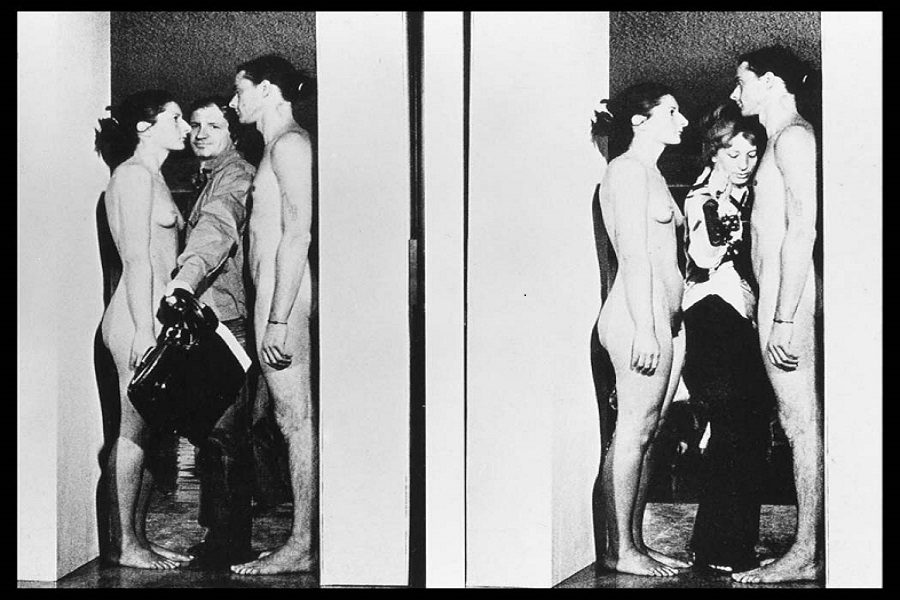
Imponderabilia (1977).Image available at delir-arte.blogspot.com
Another equally compelling joint performance was A-AAA (1978) where both artists shouted at each other in a firm-handed show of power designed to determine who had the more dominant voice. Better known is Rest Energy (1980) in which the couple faced each other, stock still for hours, holding a bow between them and the arrow between Ulay's fingers aimed directly at Abramović's heart. The strength and stamina required of both of them to maintain tension and prevent the arrow being shot was palpable. During the whole performance, microphones recorded both their heartbeats, both of them accelerated and agitated, a clear manifestation of a state of vulnerability in which responsibility and control could slip from their fingers any second.
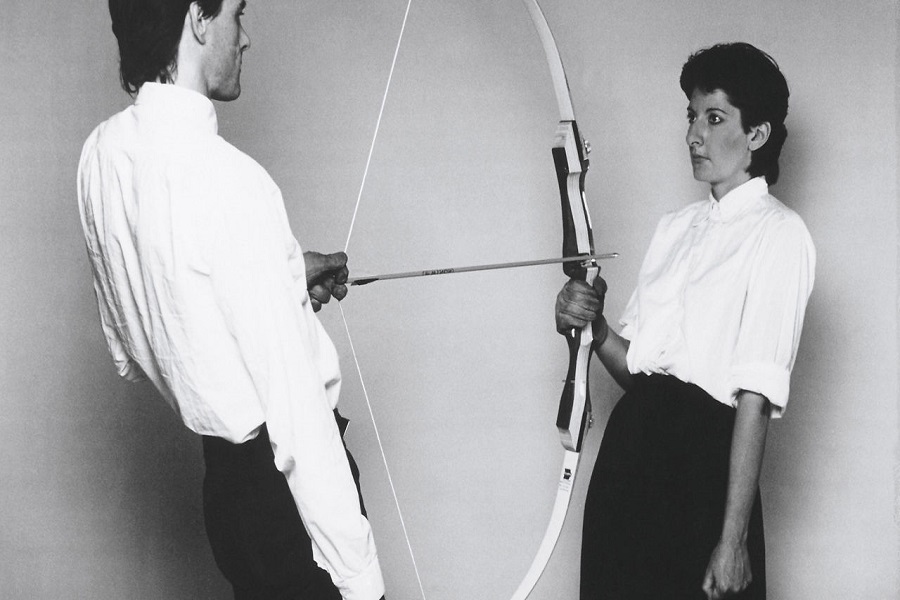
Rest Energy (1980). Image available at www.altrevelocita.it
The "The Other" series, as much a passionate romance as an artistic collaboration, had as its symbolic finale the famous staging of 1988's The Lovers. Here too, their emotional and professional rupture was played out as a work of art, portayed as a hike, each on their own, departing from opposite ends of the Great Wall Of China until meeting up again in the middle. A three month long and lonely walk culminating in one last embrace. It is an almost definitive physical and communicational goodbye - it would be 23 years until they saw each other again - and an attempt to stage the disintegration of their relationship by means of the physical and emotional fatique occasioned by a 2,000 km journey on foot. It could in some ways be called a romantic ending: unclassifiable, unorthodox and emotionally charged with mysticism.
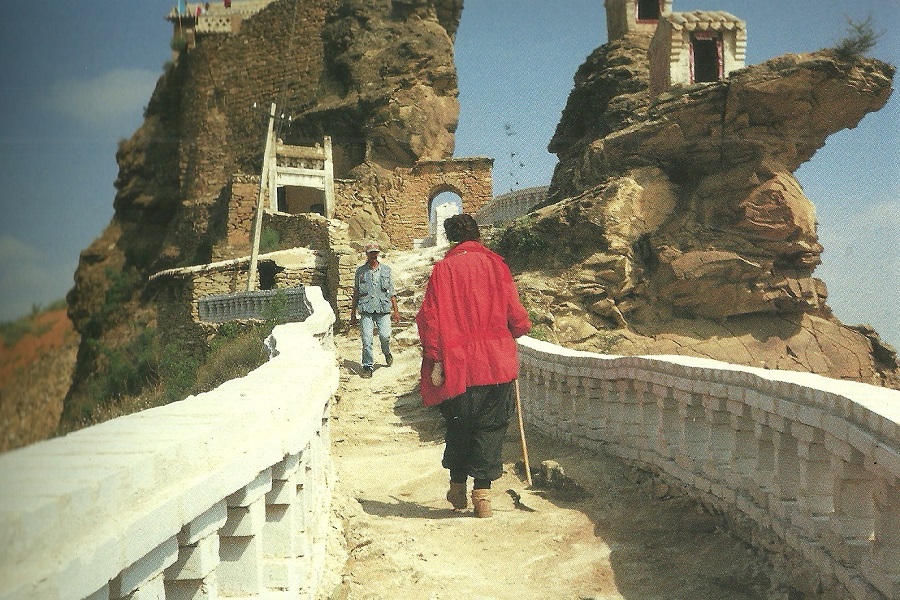
The Lovers (1988). Image available at http://inkultmagazine.com
With hindsight, Abramović's subsequent reinvention of herself as a solo artist could be defined as the crucial turning point in her career. A certain time lapse and, more importantly, long-distance travels abroad, Brasil for instance, led to a creative resurgence during the 90's that broke away, once and for all, from the conscious assumption that her life and her art would be inseparable from and fundamental to all her future productions. And so, although the body would continue to play an undeniable part, the performances evolved into spaces destined for the liberation of her own personal demons, underlying or otherwise, as well as new forms of performing as a way to explore how we relate to reality.
An illustrative example, from the early 90's, would be the object installations she herself defined under the umbrella term of Transitory Objects. By incorporating natural materials such as semi-precious stones, bones and magnets into her actions, Abramović wasn't looking to give them a function of their own, as if they were sculptures. Rather, she was using them to generate experiences and energies, as if they were everyday life rituals. One has only to remember, from the initial stages of this second phase 1990 - 1994, the Dragon Head series in which the artist sat stock still whilst various ravenous pythons, who hadn't eaten for two weeks, slithered all over her body. It's an image of potent mythic-feminine resonance.
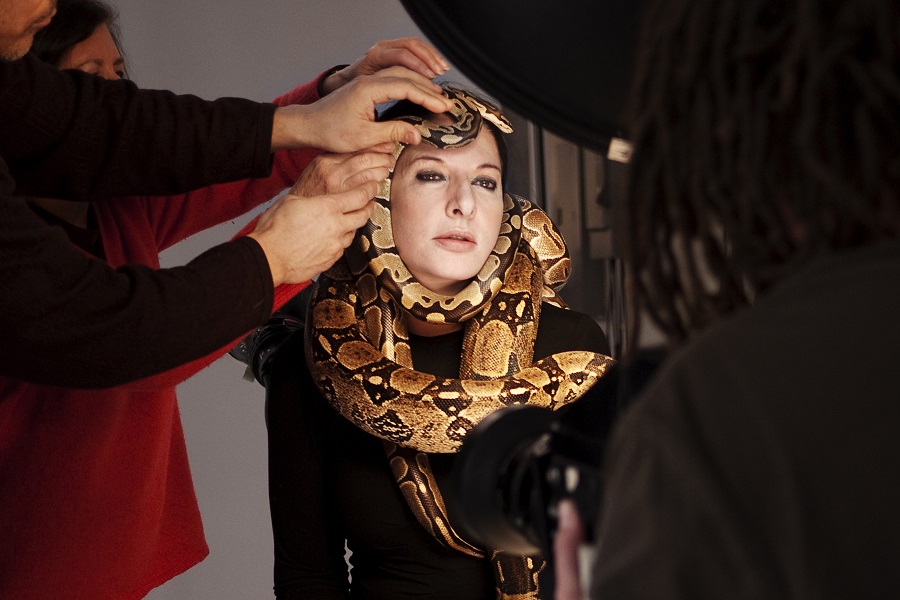
Recreation: Dragon Head (2010). Image available at mai.art
Even more striking, given the eponymous violence of the time, was Balkan Baroque (1997) which won the Gold Lion award at the Venice Biennale that same year, the Festival's highest prize. Expanding on the theme of the human skeleton, previously explored in Cleaning the Mirror (1995), Abramović used video installation to recreate the putrifying horror of armed conflict in the Balkans War. As well as projecting an image of her own parents on the walls, the artist positioned herself in the middle of the space, washing a huge pile of 1500 raw, bloodied veal bones whilst singing traditional folk songs from her childhood. The dramatic staging no doubt owed a lot to the conceptual baroque of her design but also lent it sincere and credible political weight.
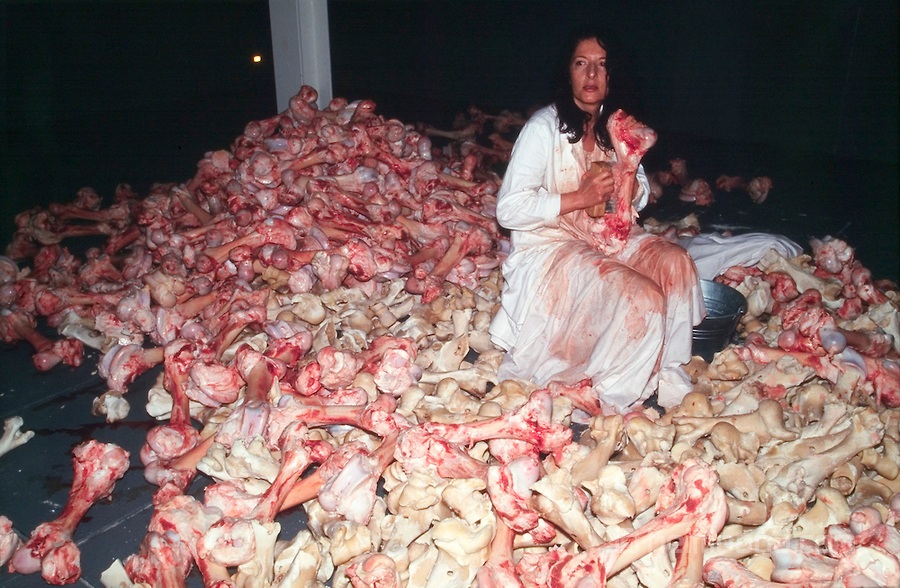
Balkan Baroque (1997). Image available at www.tropism.it
Abramović's recognition as an artist has been irrefutable since the turn of the century. Whilst, on the one hand, it is true that her active participation in various works has become so minimal as to be almost the mere fact of her being there, life and art for Abramović are intertwined as if an absolute presence, as if frozen in time. It is from this angle that she seeks to lift the public's spirit, not so much via direct emotional shock, performance surprise or Brechtian compromise but rather through other more energy-giving mechanisms such as silence, meditation and ecstasy-like consciousness: "To create a type of artwork that is almost devoid of content but still retains a kind of pure energy that will left the spectator's spirit", is how she described it in a 2008 Klaus Biesenbach interview.
In this regard, one inevitably thinks of the unforgettable The artist is present, an exhausting performance piece presented in March 2010 on the occasion of a MoMa retrospective of her entire back catalogue which remains, to date, the most important ever and, with more than 50 exhibit pieces including performances, installations, videos, photographs and collaborations along with the subsequent documentary of the same name. For three whole months, Abramović remained seated in the lobby of the New York museum for over 700 hours (during opening hours and without a break) allowing over 1,800 visitors, each in turn, one by one, to sit opposite her in total silence, separtated by just a table, and to share the imperturbable presence of the artist for as long as they considered necessary.
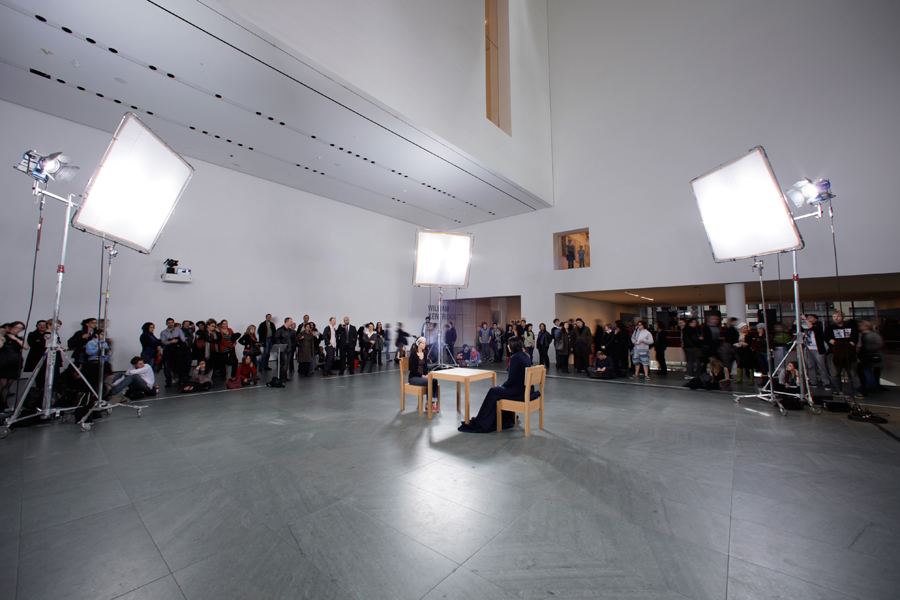
The artist is present (2010). Image available at www.filmswelike.com
Like a challenge to time, like a reflection on modern-day society's emotional alienation, the hit piece created an immediate connection between artist and spectator - no verbal communication necessary - and made the lack of communication between one fragile body with another, especially in a great metropolis like New York, even more palpable.
There were also moments of utter surprise: after 23 years of separation, Ulay appeared out of the blue on the day of the inauguration. Abramović's heart visibly missed a beat on seeing him and he was the only one with whom she had any physical contact, after a brief conversation using only their eyes.
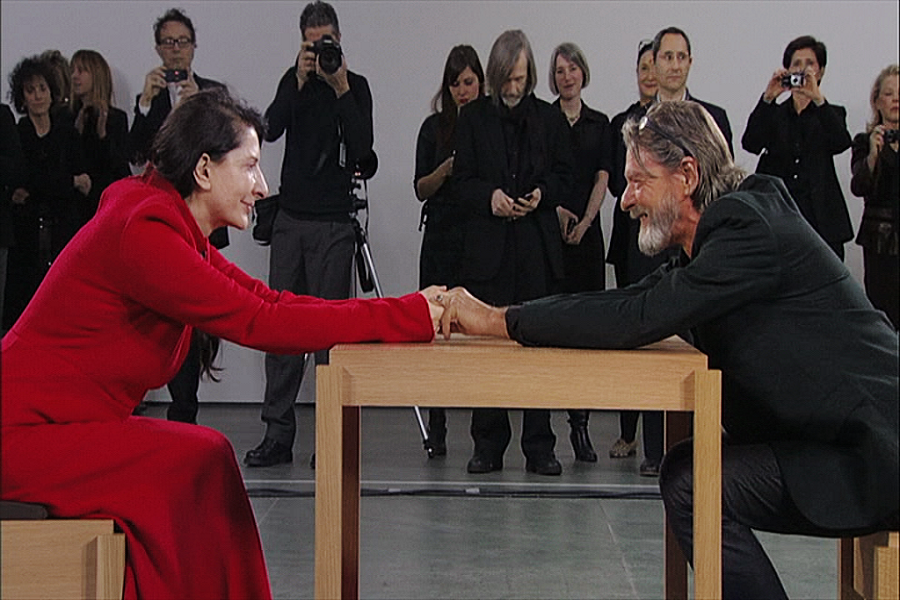
The artist is present (2010), reunion with Ulay. Image available at www.visualnews.com
But at the same time, it is no less true that diversification of format and method have been a constant in Marina Abramović's life and works, aware as she is of the increasingly global reach of what she has to offer and say. One need look no further than her much-lauded collaboration with Robert Wilson in the experimental opera The Life and Death of Marina Abramović which delved into the idea of her life's (and various deaths') leitmotifs as its narrative, with other great artists like Antony, Willem Dafoe and Wilson himself joing forces.
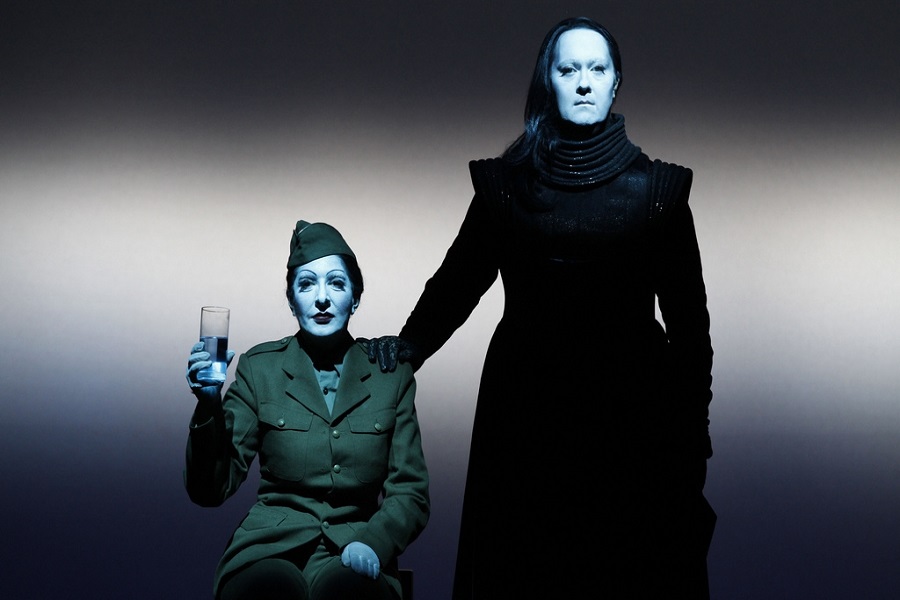
Marina Abramović and Antony in The Life and Death of Marina Abramović. Image available at www.robertwilson.com
As a final thought, one might ask oneself if, by focusing her most recent efforts on constant meta-reflection and revision of her prolific output, the potency of her artistic message has seen itself somewhat compromised by a worldwide success that has, unavoidably, transformed the scope, meaning and impact of her performances. Can those same concepts and themes of 20 or 30 years ago still be conveyed today? Given recent changes in the way artists communicate to us and the media and spaces now available to them, would it not be, rather, a case of qualitatively distinct experiences?
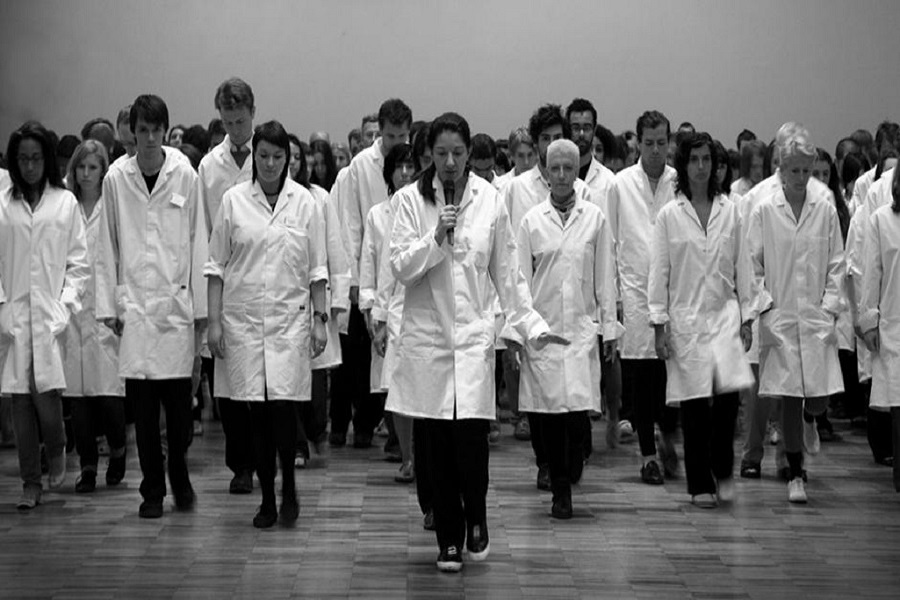
Slow-motion workshop, directed at the Whitworth Galley, Manchester (2009). Image available at passengerart.com
Art as action, live art made with the artists' own bodies is an artform belonging to a tradition predating but not predicting the digital age that came with all its short-lived sensations and hyperinformation. Neither did it anticipate a scenario of absolute trivialisation or the lionisation of those other anonymous performers of the 21st century, on youtube for instance. In any case, the conventional definition of performance as 'action that happens within a limited time frame' is in urgent need of revision. Perhaps the Marina Abramović Institue (MAI), inaugurated in 2015 in New York State, might take it upon itself to gather together a multidisciplinary think-tank to review it and instruct places of collaborative and experimental art in society today with the Serbian artist's legacy as a starting point. The "grandmother of perfomance", just turned 70, has a lot of life left in her yet.
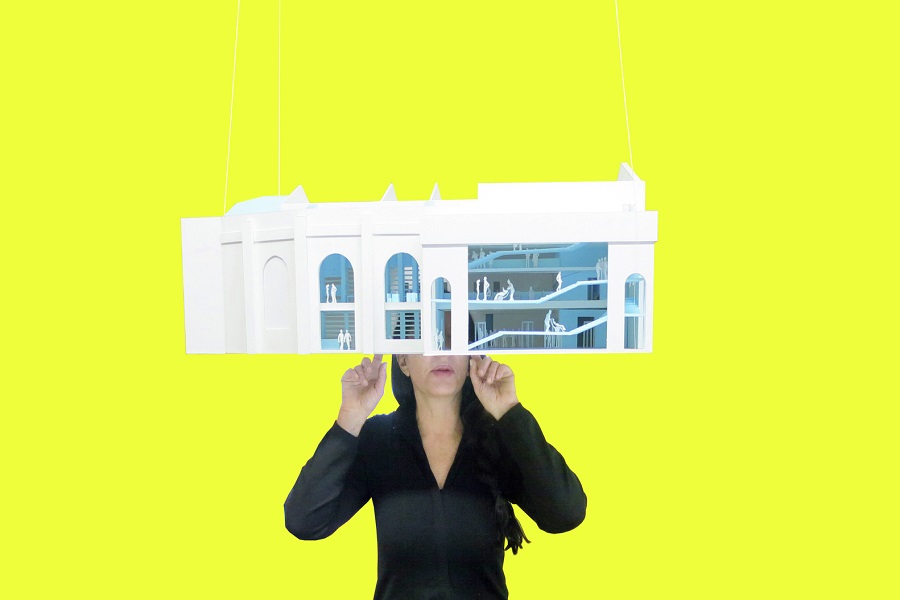
Publicity campaign for the Marina Abramovic Institute. Image available at mai.art
(Translated from the Spanish by Shauna Devlin)
- Marina Abramovic: Biography, works and exhibitions - - Alejandra de Argos -
- Details
- Written by Marisa Carrero
Jasper Johns was a small-town boy from the Deep South whose university art teacher urged and convinced him to move to New York. He had known he wanted to be a painter from the age of five and was to become one of the most influential American painters of the second half of the twentieth century.Born in Augusta, Georgia in 1930 and raised in Allendale, South Carolina, Johns' childhood love of painting lead him to study art; first at the University of South Carolina from 1946 to 1947, and later in the Parsons School of Design in New York in 1948, where his work was first exhibited. His artistic career was interrupted by two years of military service in the Korean War, part of which he spent in Japan. Upon returning to New York in 1952, Johns worked in bookshops for a few years while he familiarised himself with the city’s art scene.
Jasper Johns was a small-town boy from the Deep South whose university art teacher urged and convinced him to move to New York. He had known he wanted to be a painter from the age of five and was to become one of the most influential American painters of the second half of the twentieth century.

Jasper Johns. Image available at newsoftheartworld.com
Born in Augusta, Georgia in 1930 and raised in Allendale, South Carolina, Johns' childhood love of painting lead him to study art; first at the University of South Carolina from 1946 to 1947, and later in the Parsons School of Design in New York in 1948, where his work was first exhibited. His artistic career was interrupted by two years of military service in the Korean War, part of which he spent in Japan. Upon returning to New York in 1952, Johns worked in bookshops for a few years while he familiarised himself with the city’s art scene. The friendships he struck up there with artists such as the musician John Cage and the choreographer Merce Cunningham were to have a big influence on his understanding of art. The painter Robert Rauschenberg, a fellow exponent of abstract expressionism in the 1950s, was especially influential; although Johns would later make a complete departure from that movement and go on to create new styles. A visit to Pennsylvania to view Marcel Duchamp's The Large Glass had a huge impact on his artistic vision. With his readymades, Duchamp had invented a new creative method of transforming found objects into art. The influence of this work would lead Johns to incorporate objects such as rulers, spoons and coat hangers into his paintings.
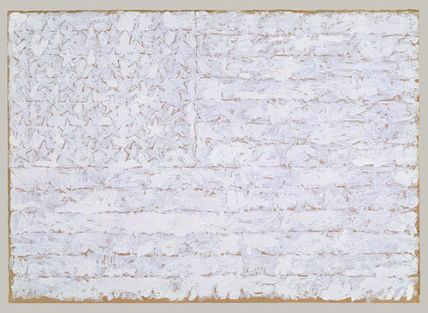

Left: Flag. Image available at www.metmuseum.org Right: Three flags. Image available at www.usc.edu
In 1954-55 he made his famous Flags, works which were hugely influential on 20th century American iconography. The paintings Flag, Target and Numbers formed part of his first great solo show at the Leo Castelli Gallery in New York. Made using the 'encaustic' technique (in which pigment is mixed with hot wax and applied to the canvas), the flag paintings were revolutionary in their apparent simplicity and power. The show made such an impact that the Museum of Modern Art (MoMA) in New York bought three of the works to exhibit in its gallery. Jasper Johns had taken a giant step forward by incorporating the everyday imagery of North American life into his work, taking “things the mind already knows” as his subject. More interested in the creative process than the work itself, Johns did not restrict himself to one single style but used diverse methods such as lithography and screen printing. At this point in his career he moved away from his roots in abstract expressionism towards new styles such as pop art, minimalism and conceptual art, which many credit him with having helped to invent. He began to incorporate objects into his paintings, transforming them into sculptures and creating original collages from the results.
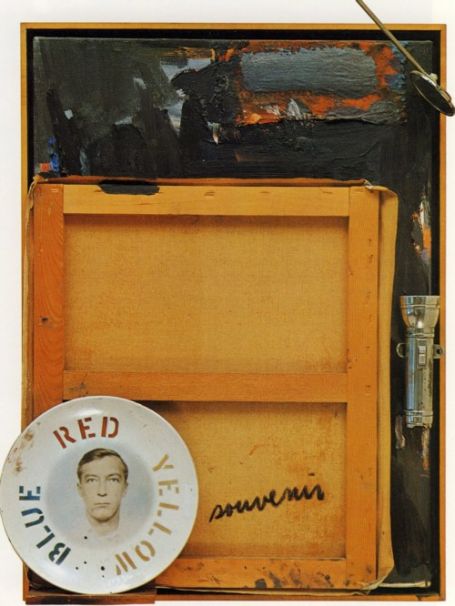
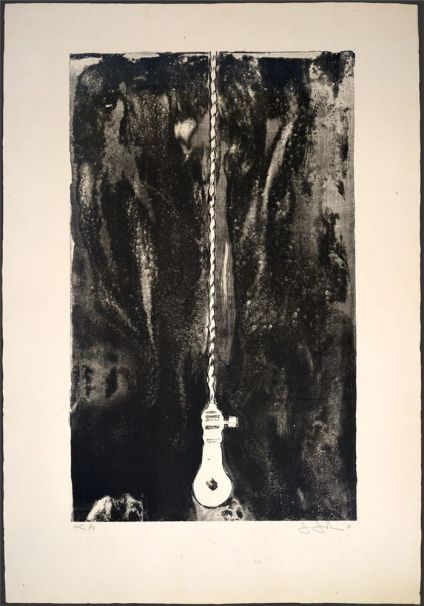
Left: Souvenir 2. Image available at www.artchive.com
Right: Recent Still Life. Image available at www.ulae.com
During the 1970s, he collaborated with many artists of the day, such as Andy Warhol, Robert Morris and Bruce Naumann. These collaborations helped to further his career and allowed him to continue his artistic studies and research. During this period Johns took on new perspectives and created new art forms, such as his illustrations for Frank O'Hara's book of ‘poem-paintings’, In Memory Of My Feelings. In 1964 he made one of his most famous prints, Ale Cans; an image of two cans of Ballantine Ale which he had previously made as a bronze sculpture in 1960. He searched for different ways of seeing and representing the same objects through a variety of disciplines, including printmaking, sculpture and even photography.
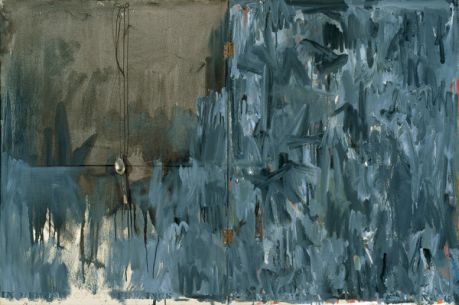
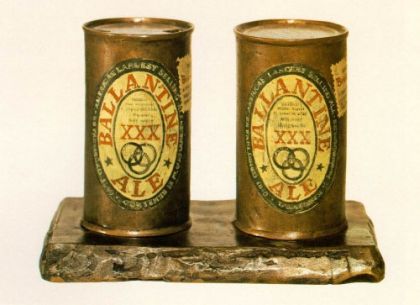
Left: In Memory of My Feelings. Image available at greg.org
Right: Two Ale Cans. Image available at www.theartsdesk.com
For some of Johns’ followers and students, the seventies marked a transition over to a more autobiographical style that was quite different from his early work. He paid homage to Cezanne and Picasso; dividing his paintings into various panels and creating works full of primary colours, such as Scent (1973-74) and the triptych Weeping Woman (1975). In this period he seemed obsessed with repetition and he remade images using a variety of artistic techniques and mediums. He made his friend John Cage’s aphorism his own: “if you do something more than once you get better results”. For Johns it was a matter of searching for the similarities and differences between the various representations that he created. Following a retrospective at the Whitney Museum of American Art in New York, Johns’ work was exhibited in galleries across Europe, including the 1978 Venice Biennale exhibition, and a show of 'working proofs' at the Kunstmuseum in Basel, among others.
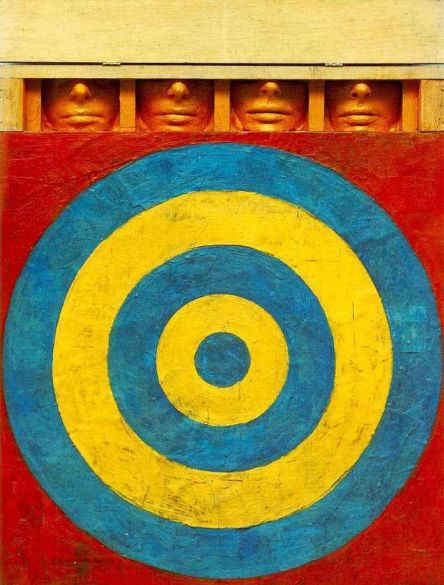
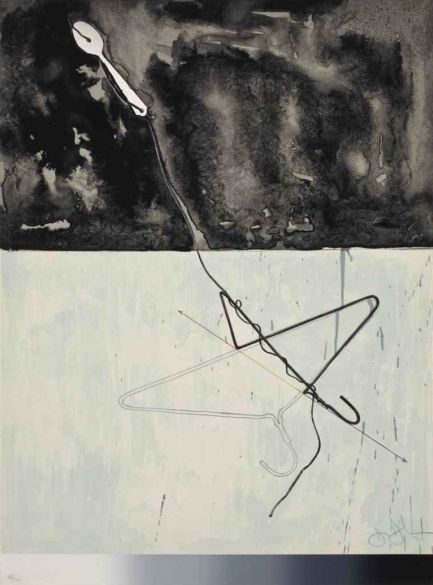
Left: Target With Four Faces. Image available at www.jasper-johns.org
Right: Coat Hanger and Spoon. Image available at www.christies.com
Johns’ work would change direction once again, as he experimented with innovative art forms and began a new creative cycle. For the 1987 exhibition The Seasons at the MoMA, Johns created a series of paintings called Spring, Summer, Fall and Winter which included human figures. That same year, the Reina Sofía Museum in Madrid hosted one of the most important retrospective shows of his career, featuring 180 works from 1960-1985. The show was curated by Riva Castleman, the director of the Department of Prints and Illustrated Books at the MoMA.
His work began to fetch incredible prices at auction, making Johns the most sought-after living artist of the day. However, throughout all of the experimentation and changes in style over his career, he never stopped creating. Nor did he ever abandon his love for the colour grey, as demonstrated in paintings such as Bridge (1997), Catenary (I call to the Grave) (1998) and Near the Lagoon (2003), in which he suspended strings across almost completely grey canvasses. His work returned to Spain in 2011 with a new retrospective exhibition organised by the Valencia Institute of Modern Art, which included the first public showing of a ‘New Sculpture’ he had made four years earlier.
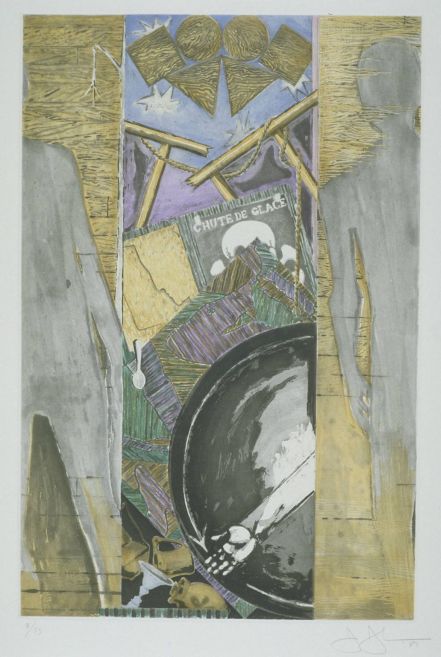
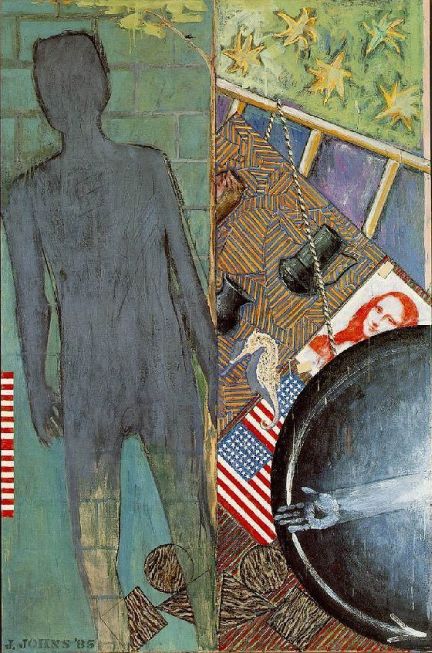
Left: Fall. Image available at dexedrina.blogspot.com.es
Right: Summer. Image available at www.jasper-johns.org
Famously, Johns said that “to be an artist you have to give up everything, including the desire to be a good artist”. Perhaps this explains the continuous shifts he made in his artistic trajectory; a restless man who constantly reinvented his style. Yet aside from this, his great power is evident in the overwhelming influence of his work on the following generations. He remains one of the most world’s most valuable living artists, whose work fetches astronomical prices at auction.
Even today at the age of 86, Johns continues to be news in the art world, as demonstrated by the success of his 2014 exhibition at the MoMA in New York, Regrets. This series of paintings, drawings and prints created during the previous year and a half were all based on a single photograph of the artist Lucian Freud, taken in 1964.
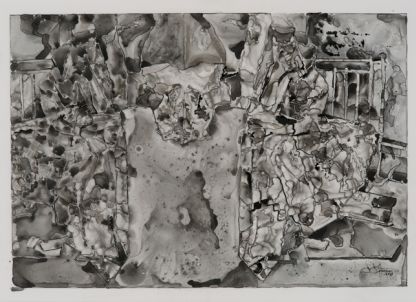
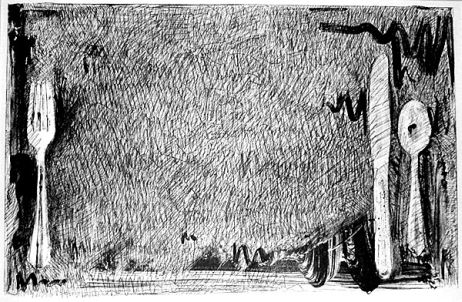
Left: Untitled. Image available at www.theartsdesk.com
Right: In Memory. Image available at www.spaightwoodgalleries.com
Johns once said that his work was “largely concerned with relations between seeing and knowing, seeing and saying, seeing and believing”. Throughout his entire career he has seen, known and created using almost every type of material and technique (including lithography, screen-printing, engraving and sculpture), producing a unique body of work and forging a movement of his own within the art world. For the next generation of artists that follow in his wake, Jasper Johns remains one of the great masters of the 20th century.
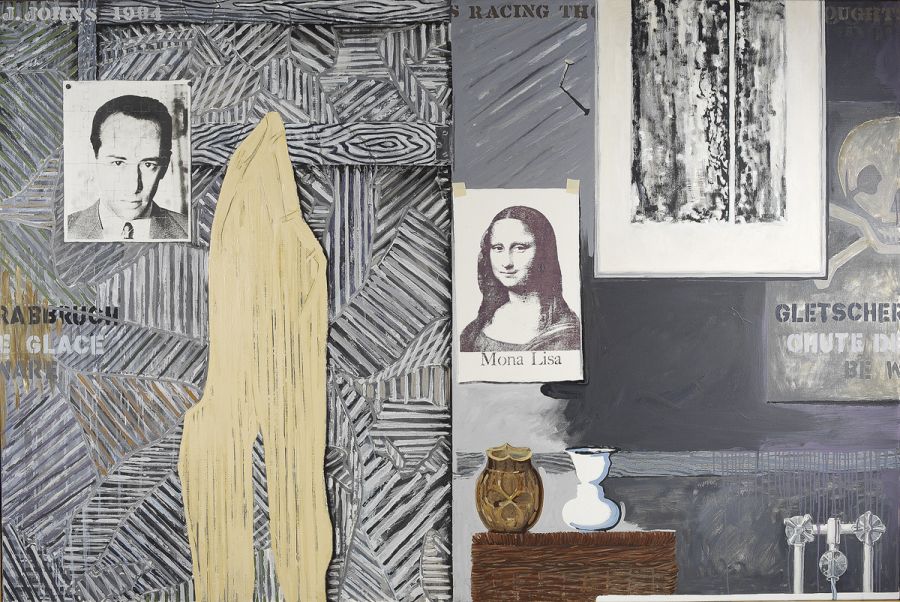
Above: Racing Thoughts. Image available at www.nj.com 7 February 2008
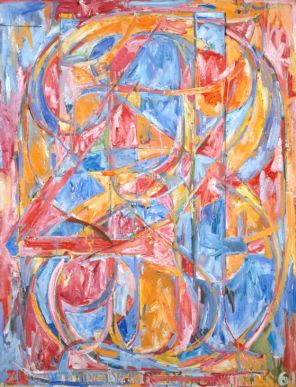
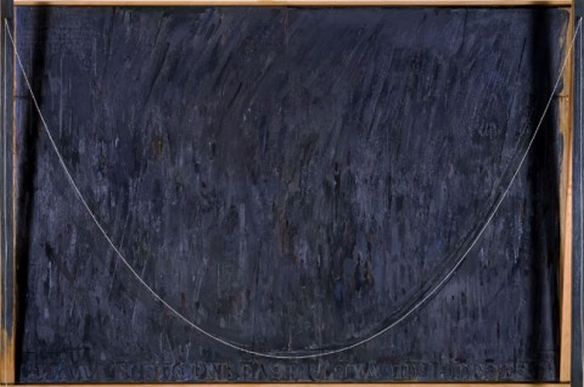
Left: Jasper Johns. Image available at drawpaintprint.tumblr.com
Right: Catenary. Image available at visualarts.walkerart.org
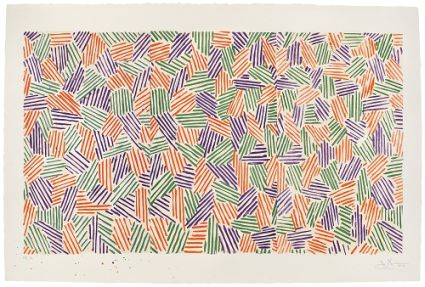
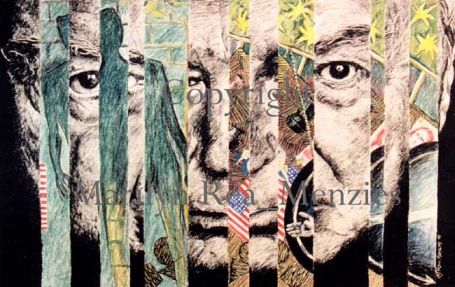
Left, above: Scent. Image available at www.artnet.com
Right, above: Homenage to Jasper Johns. Image available at www.tapestry.co.nz

0-9. Image available at www.jasper-johns.org
Translated from the Spanish by Ben Riddick
- Jasper Johns. Biografía, obras y exposiciones - - Página principal: Alejandra de Argos -

